 | –≠–ª–µ–∫—Ç—Ä–æ–Ω–Ω—ã–π –∫–æ–º–ø–æ–Ω–µ–Ω—Ç: W742E81A | –°–∫–∞—á–∞—Ç—å:  PDF PDF  ZIP ZIP |

Preliminary W742E81A/W742C81A
4-BIT MICROCONTROLLER
Publication Release Date: April 2000
- 1 - Revision A1
1. GENERAL DESCRIPTION
The W742E81A/W742C81A is a high-performance 4-bit microcontroller (
µ
C) that provides an LCD
driver. The device contains a 4-bit ALU, two 8-bit timers, two dividers (for two oscillators) in dual-
clock operation, a 40
◊
4 LCD driver, six 4-bit I/O ports (including 1 output port for LED driving), and
one channel DTMF generator. There are also five interrupt sources and 16-levels subroutine nesting
for interrupt applications. The W742E81A/W742C81A operates on very low current and has two
power reduction modes, that is the dual-clock slow operation and STOP mode, which help to
minimize power dissipation.
2. FEATURES
∑
Operating voltage: 2.4V
-
3.8V
∑
Dual-clock operation or single-clock operation (By option)
∑
Main-oscillator
-
Connect to 3.58 MHz crystal or 400 KHz that can be selected by option code
-
Crystal or RC oscillator can be selected by code option (W742E81A)
-
Connect to 2 MHz typical RC oscillator (W742C81A)
∑
Sub-oscillator
-
Connect to 32768 Hz crystal only
∑
Memory
-
16384 x 16 bits program flash EEPROM (including 64K x 4 bit look-up table)
-
2048 x 4 bits data RAM (including 16 nibbles x 16 pages working registers)
-
40 x 4 LCD data RAM
∑
24 input/output pins
-
Port for input only: 1 ports/4 pins(RC)
-
Input/output ports: 3 ports/12 pins(RA, RB & RD)
-
High sink current output port for LED driving: 1 port /4 pins(RE)
-
Port for output only: 1 port/ 4 pins(RF)
∑
Power-down mode
-
Hold function: no operation (main-oscillator and sub-oscillator still operate)
-
Stop function: no operation (main-oscillator and sub-oscillator are stopped)
-
Dual-clock slow operation mode: system is operated by the sub-oscillator (F
OSC
=Fs and Fm is
stopped)
∑
Five types of interrupts
-
Four internal interrupts (Divider0, Divider1, Timer 0, Timer 1)
-
One external interrupts (RC Port)

Preliminary W742E81A/W742C81A
- 2 -
∑
LCD driver output
-
40 segments x 4 commons
-
1/4 duty 1/3 bias driving mode
-
Clock source should be the sub-oscillator clock in the dual-clock operation mode
∑
MFP output pin
-
Output is software selectable as modulating or nonmodulating frequency
-
Works as frequency output specified by Timer 1
∑
DTMF output pin
-
Output is one channel Dual Tone Multi-Frequency signal for dialling
∑
Two built-in 14-bit frequency dividers
-
Divider0: the clock source is the output of the main-oscillator
-
Divider1: the clock source is the output of the sub-oscillator (dual-clock mode) or the Fosc/128
(single-clock mode)
∑
Two built-in 8-bit programmable countdown timers
-
Timer 0: one of two internal clock frequencies (F
OSC
/4 or F
OSC
/1024) can be selected
-
Timer 1: with auto-reload function and one of three internal clock frequencies (F
OSC,
F
OSC
/64 or
Fs) can be selected by MR1 register; and the specified frequency can be delivered to MFP pin
∑
Built-in 18/15-bit watchdog timer selectable for system reset; enable the watch dog timer or not is
determined by code option
∑
Powerful instruction set: 142 instructions
∑
16-levels subroutine (include interrupt) nesting
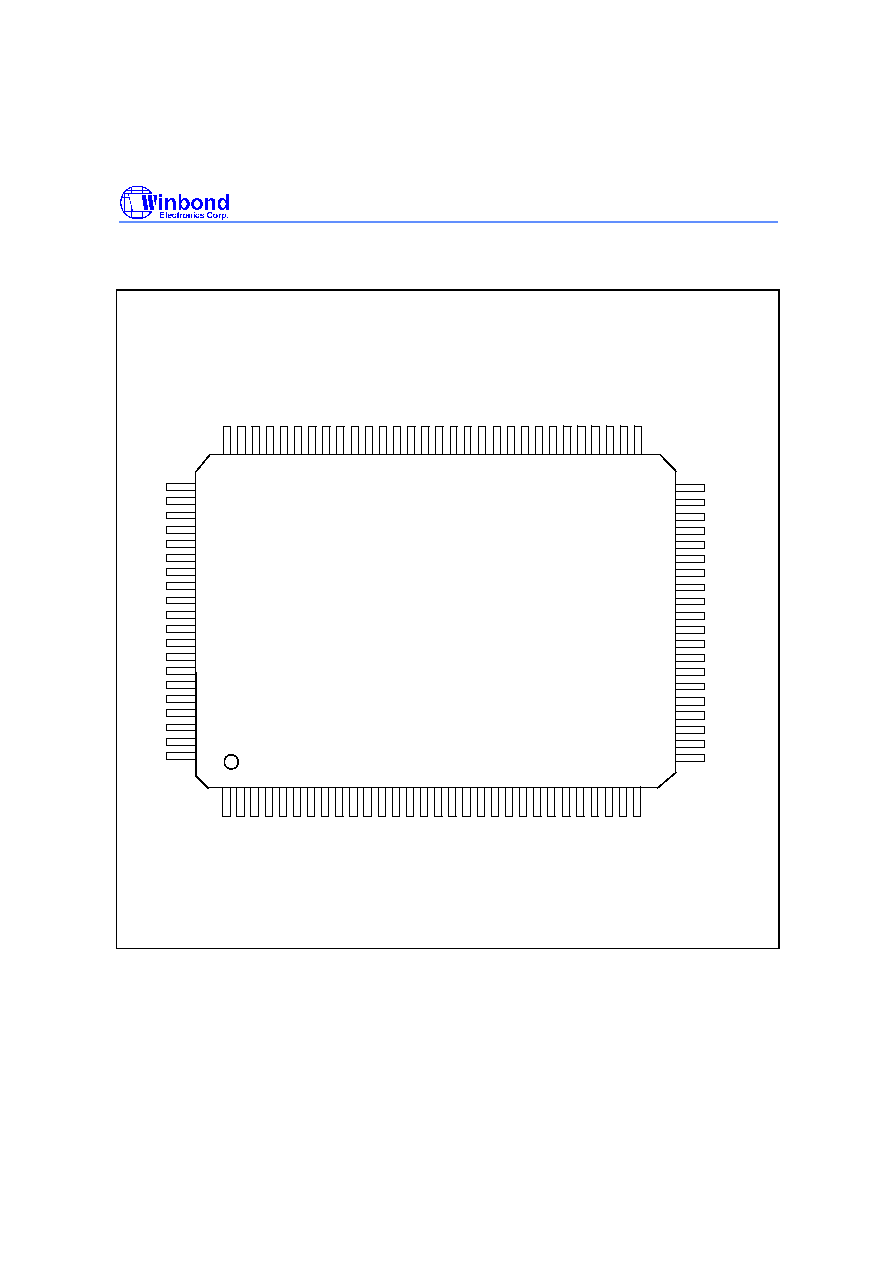
Preliminary W742E81A/W742C81A
Publication Release Date: April 2000
- 3 - Revision A1
3. PIN CONFIGURATION
For W742E81A
80 79 78 77 76 75 74 73 72 71 70 69 68 67 66 65 64 63 62
1
2
3
4
5
6
7
8
9 10 11 12 13 14 15 16 17 18 19
36
37
38
39
40
41
42
43
44
45
46
47
48
81
82
83
84
85
86
87
88
89
90
91
92
RC1
RC0
RB3
RB2
RB1
RB0
RA3
RA1
SEG31
SEG30
SEG29
SEG28
SEG27
SEG26
SEG25
SEG24
SEG23
R
E
1
R
E
2
SEG22
SEG21
SEG20
SEG19
RA0
RA2
20 21 22 23 24
49
50
61 60 59 58 57
93
94
95
N
C
NC
RD0
RC3
RC2
25 26 27 28 29
56 55 54 53 52
96
97
RD2
RD1
98
99
100
NC
RD3
31
32
33
34
35
SEG18
SEG17
SEG16
SEG15
N
C
R
E
0
R
E
3
R
F
0
R
F
1
R
F
2
R
F
3
V
S
S
S
E
G
0
S
E
G
1
S
E
G
2
S
E
G
3
S
E
G
4
S
E
G
5
S
E
G
6
S
E
G
7
S
E
G
8
S
E
G
9
S
E
G
1
0
S
E
G
1
1
S
E
G
1
2
S
E
G
1
3
N
C
N
C
N
C
51
30
N
C
N
C
N
C
S
E
G
3
3
S
E
G
3
4
S
E
G
3
5
S
E
G
3
6
S
E
G
3
7
S
E
G
3
8
S
E
G
3
9
C
O
M
3
C
O
M
2
C
O
M
1
C
O
M
0
V
D
D
2
V
D
D
1
D
H
2
D
H
1
X
O
U
T
2
X
I
N
2
V
D
D
X
O
U
T
1
X
I
N
1
D
T
M
F
R
E
S
N
C
N
C
N
C
S
E
G
1
4
NC
S
E
G
3
2
MFP
NC
NC
N
C
NC
N
C
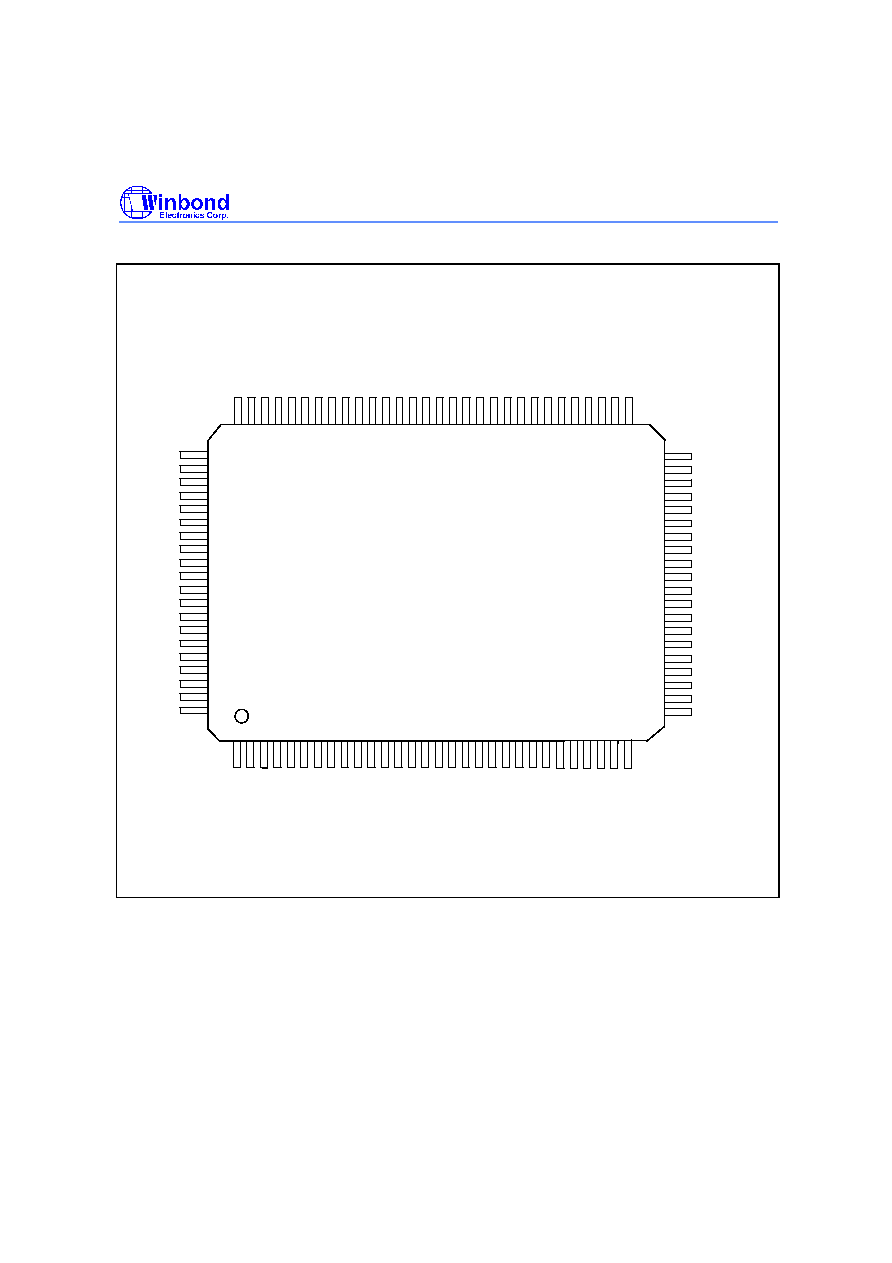
Preliminary W742E81A/W742C81A
- 4 -
For W742C810
80 79 78 77 76 75 74 73 72 71 70 69 68 67 66 65 64 63 62
1 2
3 4 5 6 7 8 9 10 11 12 13 14 15 16 17 18 19
36
37
38
39
40
41
42
43
44
45
46
47
48
81
82
83
84
85
86
87
88
89
90
91
92
RC1
RC0
RB3
RB2
RB1
RB0
RA3
RA1
SEG31
SEG30
SEG29
SEG28
SEG27
SEG26
SEG25
SEG24
SEG23
R
E
1
R
E
2
SEG22
SEG21
SEG20
SEG19
RA0
RA2
20 21 22 23 24
49
50
61 60 59 58 57
93
94
95
N
C
NC
RD0
RC3
RC2
25 26 27 28 29
56 55 54 53 52
96
97
RD2
RD1
98
99
100
NC
RD3
31
32
33
34
35
SEG18
SEG17
SEG16
SEG15
N
C
R
E
3
R
F
0
R
F
1
R
F
2
R
F
3
V
S
S
S
E
G
0
S
E
G
1
S
E
G
2
S
E
G
3
S
E
G
4
S
E
G
5
S
E
G
6
S
E
G
7
S
E
G
8
S
E
G
9
S
E
G
1
0
S
E
G
1
1
S
E
G
1
2
S
E
G
1
3
N
C
N
C
N
C
51
30
N
C
N
C
N
C
S
E
G
3
3
S
E
G
3
4
S
E
G
3
5
S
E
G
3
6
S
E
G
3
7
S
E
G
3
8
S
E
G
3
9
C
O
M
3
C
O
M
2
C
O
M
1
C
O
M
0
V
D
D
2
V
D
D
1
D
H
2
D
H
1
X
O
U
T
2
X
I
N
2
V
D
D
X
O
U
T
1
X
I
N
1
D
T
M
F
R
E
S
N
C
N
C
N
C
MFP
N
C
NC
N
C
RE0
N
C
SEG14
N
C
SEG32
N
C

Preliminary W742E81A/W742C81A
Publication Release Date: April 2000
- 5 - Revision A1
4. PIN DESCRIPTION
SYMBOL
I/O
FUNCTION
XIN2
I
Input pin for sub-oscillator.
Connected to 32.768 KHz crystal only.
XOUT2
O
Output pin for sub-oscillator with internal oscillation capacitor. Connected
to 32.768 KHz crystal only.
XIN1
I
Input pin for main-oscillator.
Connected to 3.58 MHz or 400 KHz crystal or RC to generate system
clock.
XOUT1
O
Output pin for main-oscillator.
Connected to 3.58 MHz or 400 KHz crystal or RC to generate system
clock.
RA0
-
RA3
I/O Input/Output port.
Input/output mode specified by port mode 1 register (PM1).
RB0
-
RB3
I/O Input/Output port.
Input/output mode specified by port mode 2 register (PM2).
RC0
-
RC3
I
4-bit port for input only.
Each pin has an independent interrupt capability.
RD0
-
RD3
I/O Input/Output port.
Input/output mode specified by port mode 5 register (PM5).
RE0
-
RE3
O
Output port only. With high sink current capacity for the LED application.
RF0
-
RF3
O
Output port only.
MFP
O
Output pin only.
This pin can output modulating or nonmodulating frequency, or Timer 1
specified frequency. It can be selected by bit 0 of BUZCR (BUZCR.0).
DTMF
O
This pin can output dual-tone multifrequency signal for dialling.
RES
I
System reset pin with pull-high resistor.
SEG0
-
SEG39
O
LCD segment output pins.
COM0
-
COM3
O
LCD common signal output pins.
The LCD alternating frequency can be selected by code option.
DH1, DH2
I
Connection terminals for voltage doubler (halver) capacitor.
V
DD1
V
DD2
I
Positive (+) supply voltage terminal.
Refer to Functional Description.
V
DD
I
Positive power supply (+).
V
SS
I
Negative power supply (-).
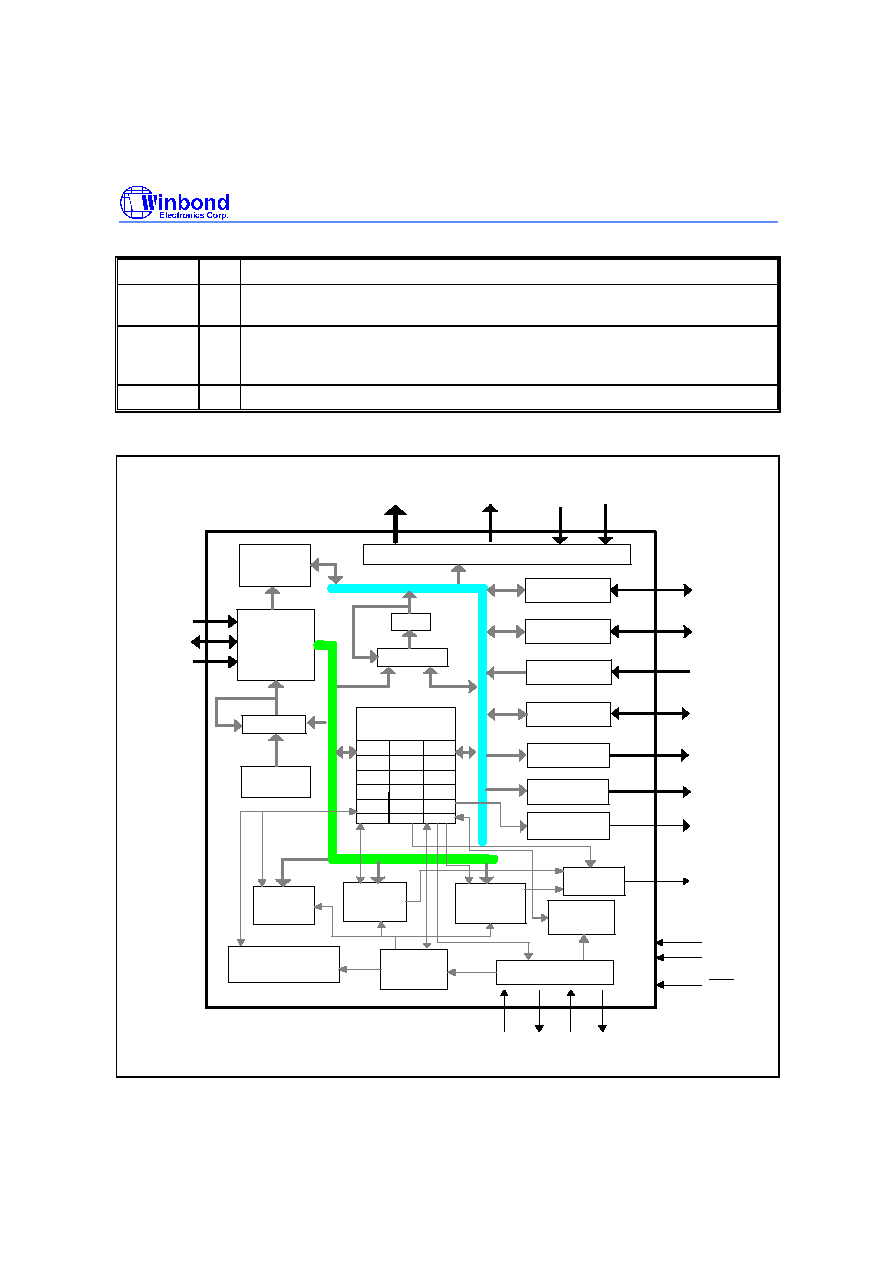
Preliminary W742E81A/W742C81A
- 6 -
Pin Description, continued
SYMBOL I/O
FUNCTION
V
PP
I
Voltage control pin for the flash EEPROM programming, erasing and verifying.
This pin has the built-in pull-low resistor.
MODE
I
This pin can be used as mode selection control; data read/write clock;
program/erase control or address counter control in the flash EEPROM erasing,
programming or verifying mode. This pin has the built-in pull-low resistor.
DATA
I/O Data I/O pin with the built-in pull-low resistor.
5. BLOCK DIAGRAM
LCD DRIVER
PC
STACK
(16 Levels)
RAM
(2048*4)
ALU
Timer 0
(8 Bit)
Timing Generator
PORT RA
PORT RB
PORT RC
Modulation
Frequency
Pulse
SEG0~SEG39
COM0~COM3
RA0-3
RB0-3
RC0-3
RD0-3
MFP
XIN1 XOUT1 XIN2
XOUT2
VDD
VSS
VDD1-2
DH1-2
Flash
EEROM
(16384*16)
(look_up table
64K*4)
Timer 1
(8 Bit)
ACC
RES
Divider 0
(14 Bit)
Watch Dog Timer
(4 Bit)
HCF
PEF
HEF
IEF
Central
Control
Unit
EVF
SEF
PSR0
SCR
PR
MR0
MR1
.
.
.
PORT RE
MUX
SEL
+1(+2)
PORT RD
PM0
Divider 1
(12/14 Bit)
RE0-3
PORT RF
RF0-3
DTMF
Generator
DTMF
PM1
DTMF
DTCR
VPP
DATA
MODE
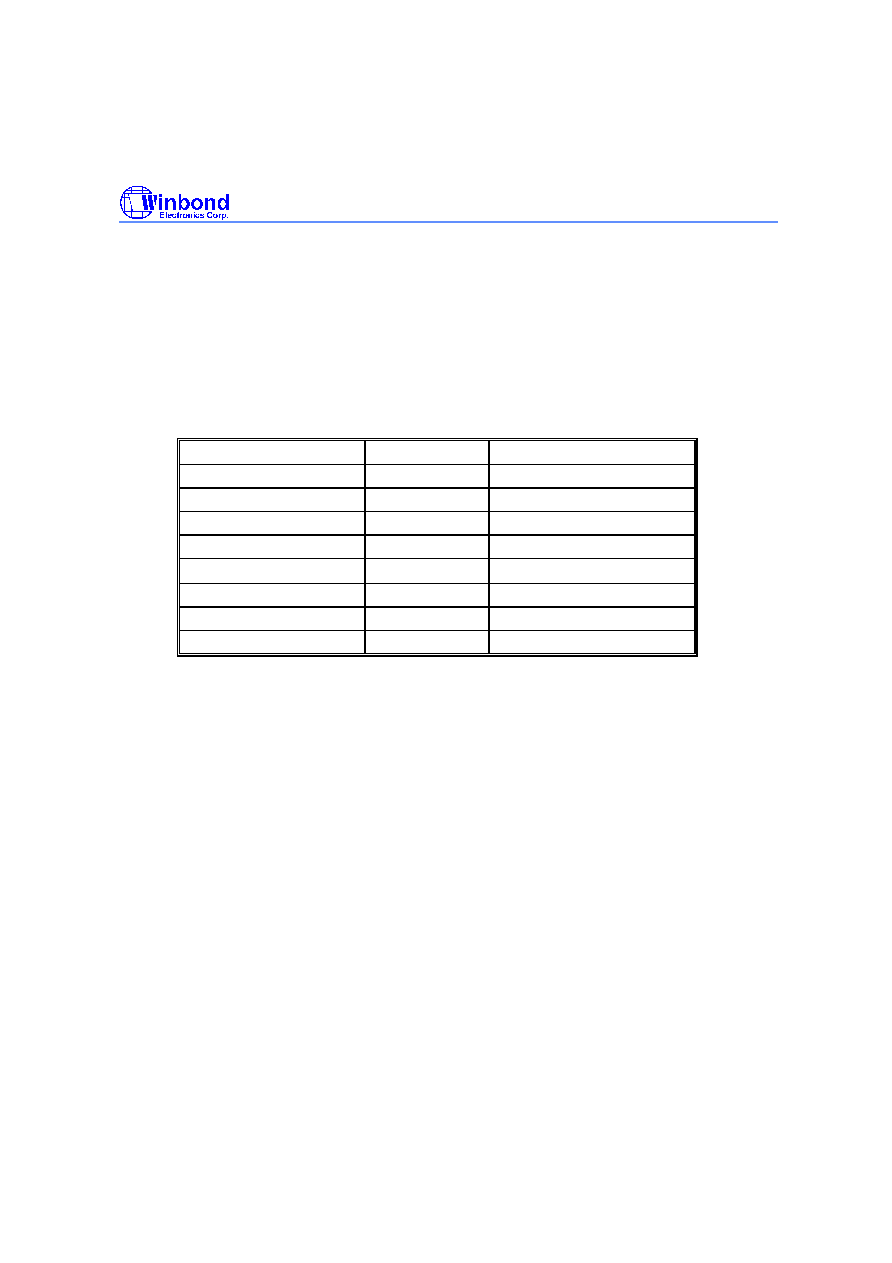
Preliminary W742E81A/W742C81A
Publication Release Date: April 2000
- 7 - Revision A1
6. FUNCTIONAL DESCRIPTION
6.1 Program Counter (PC)
Organized as an 14-bit binary counter (PC0 to PC13), the program counter generates the addresses
of the 16384
◊
16 on-chip ROM containing the program instruction words. Before the jump or
subroutine call instructions are to be executed, the destination ROM page must be determined firstly.
The confirmation of the ROM page can be done by executing the MOV ROMPR, #I or MOV ROMPR,
R instruction. When the interrupt or initial reset conditions are to be executed, the corresponding
address will be loaded into the program counter directly. The format used is shown below.
Table 1 Vector address and interrupt priority
ITEM
ADDRESS
INTERRUPT PRIORITY
Initial Reset
0000H
-
INT 0 (Divider0)
0004H
1st
INT 1 (Timer 0)
0008H
2nd
INT 2 (Port RC)
000CH
3rd
INT 3 (Divider1)
0014H
4th
INT 4 (Timer 1)
0020H
5th
JP Instruction
XXXXH
-
Subroutine Call
XXXXH
-
6.2 Stack Register (STACK)
The stack register is organized as 49 bits x 16 levels (first-in, last-out). When either a call subroutine
or an interrupt is executed, the program counter will be pushed onto the stack register automatically.
At the end of a call subroutine or an interrupt service subroutine, the RTN instruction must be
executed to pop the contents of the stack register into the program counter. (Refer to Table 8)
When the stack register is pushed over the sixteen levels, the contents of the first level will be lost. In
other words, the stack register is always sixteen levels deep.
6.3 Program Memory (ROM)
The read-only memory (ROM) is used to store program codes; and the look-up table is arranged as
65536 x 4 bits. The program ROM is divided into eight pages; the size of each page is 2048 x 16 bits.
So the total ROM size is 16384 x 16 bits. Before the jump or subroutine call instructions are to be
executed, the destination ROM page must be determined firstly. The ROM page can be selected by
executing the MOV ROMPR,#I or MOV ROMPR, R instruction. But the branch decision instructions
(e.g. JB0, SKB0, JZ, JC, ...) must jump to the same ROM page which the branch decision instructions
are in. The whole ROM can store both instruction codes and the look-up table. Each look-up table
element is composed of 4 bits, so the look-up table can be addressed up to 65536 elements.
Instruction MOVC R is used to read the look-up table content and transfer table data to the RAM. But
before reading the addressed look-up table content, the content of the look-up table pointer (TAB)
must be determined firstly. The address of the look-up table element is allocated by the content of
TAB. The MOV TAB0 (TAB1, TAB2, TAB3), R instructions are used to allocate the address of the
wanted look-up table element. The TAB0 register stores the LSB 4 bits of the look-up table address.
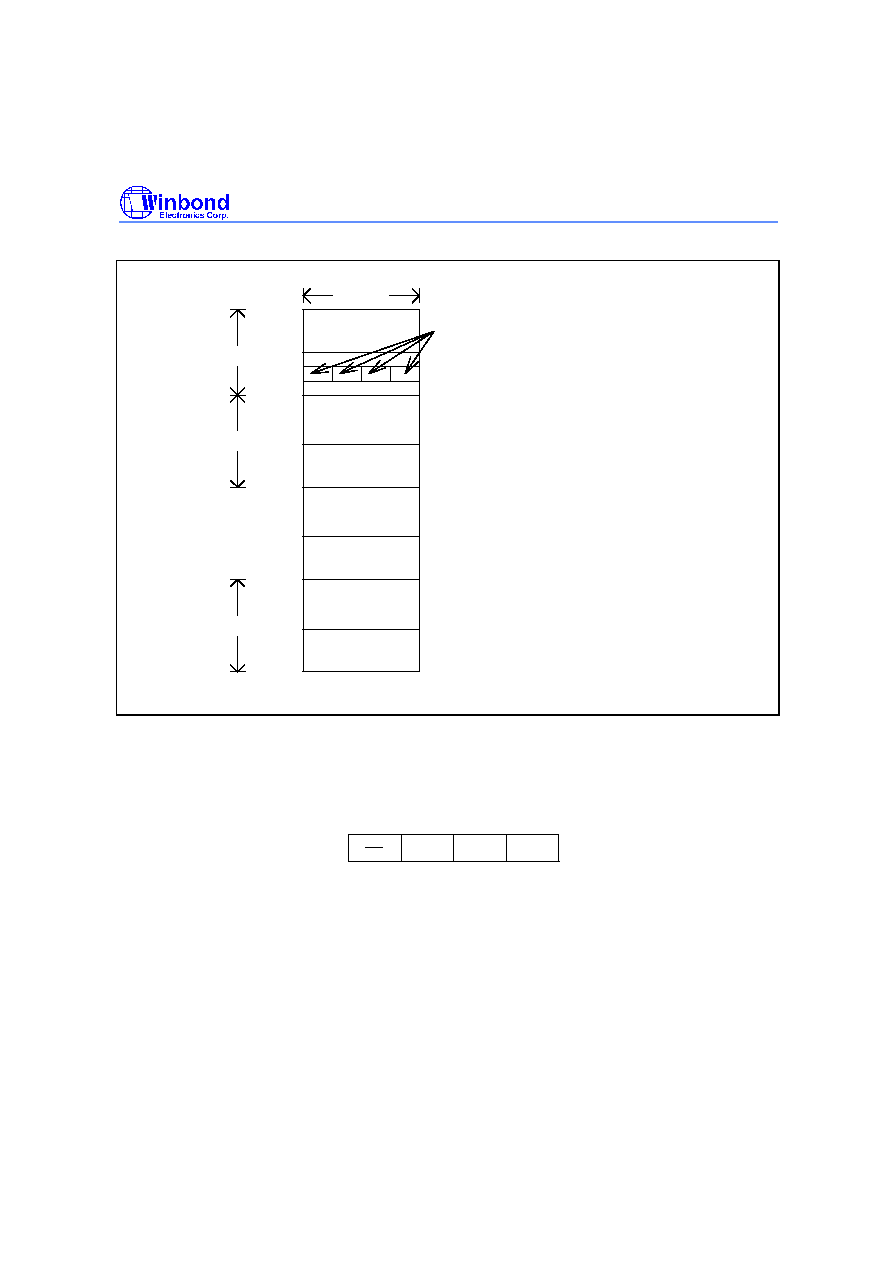
Preliminary W742E81A/W742C81A
- 8 -
The organization of the program
memory is shown in Figure 6-1
.
0000H
16 bits
16384 x 16 bits
07FFH
0400H
:
:
Each element (4 bits) of the look-up table
:
03FFH
:
0800H
0FFFH
0C00H
:
0BFFH
:
1st page
3C00H
:
3BFFH
:
3800H
3FFFH
2nd page
8th page
Look-up table address:
0000H
:
0FFFH
Look-up table address:
1000H
:
1FFFH
Look-up table address:
2000H
:
2FFFH
Look-up table address:
3000H
:
3FFFH
Look-up table address:
E000H
:
EFFFH
Look-up table address:
F000H
:
FFFFH
:
:
:
:
Figure 6-1 Program Memory Organization
6.3.1 ROM Page Register (ROMPR)
The ROM page register is organized as a 4-bit binary register. The bit descriptions are as follows:
W
W
0
1
2
3
ROMPR
W
Note: W means write only.
Bit 3 is reserved.
Bit 2, Bit 1, Bit 0 ROM page preselect bits:
000 = ROM page 0 (0000H - 07FFH)
001 = ROM page 1 (0800H - 0FFFH)
010 = ROM page 2 (1000H - 17FFH)
011 = ROM page 3 (1800H - 1FFFH)
100 = ROM page 4 (2000H - 27FFH)
101 = ROM page 5 (2800H - 2FFFH)
110 = ROM page 6 (3000H - 37FFH)
111 = ROM page 7 (3800H - 3FFFH)
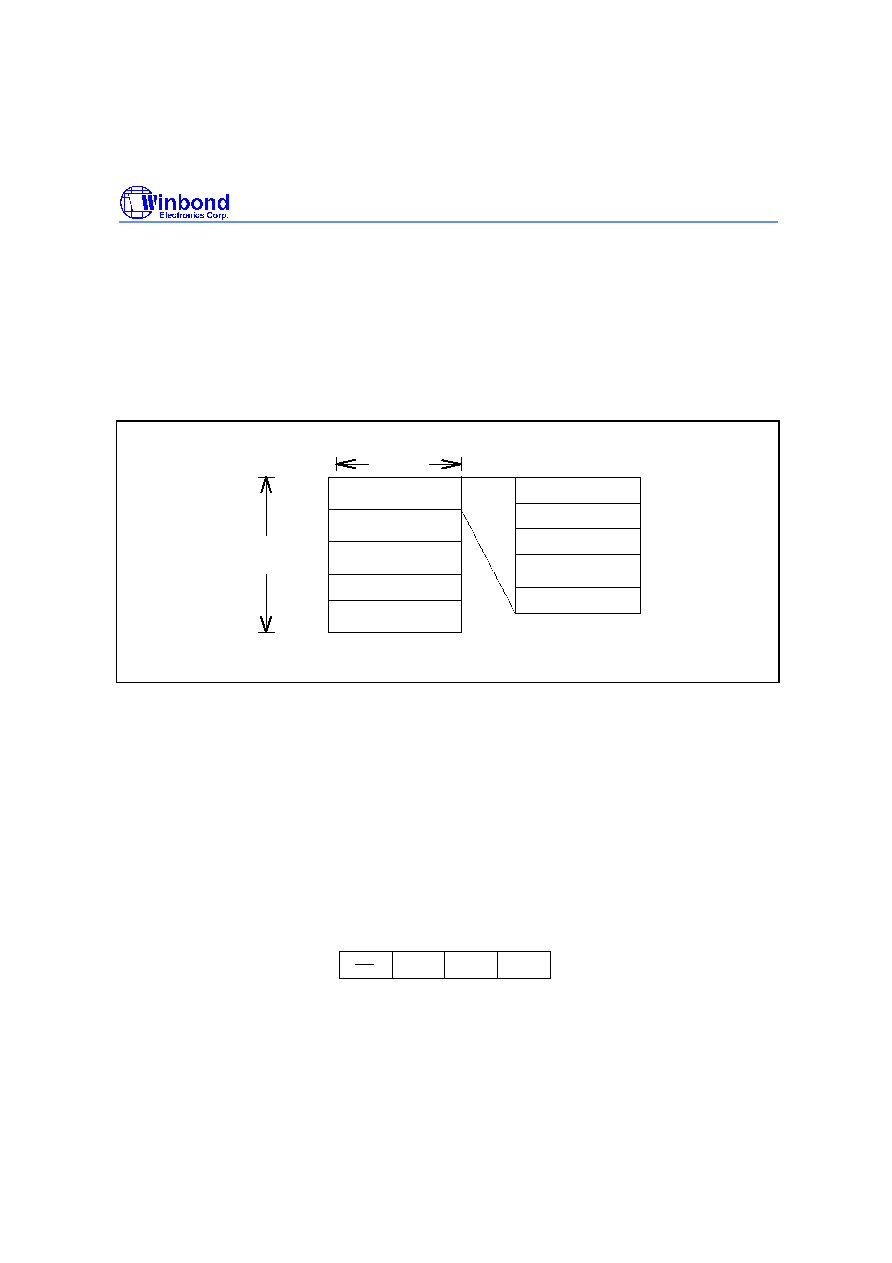
Preliminary W742E81A/W742C81A
Publication Release Date: April 2000
- 9 - Revision A1
6.4 Data Memory (RAM)
6.4.1 Architecture
The static data memory (RAM) used to store data is arranged as 2048
◊
4 bits. The data RAM is
divided into sixteen banks; each bank has 128
◊
4 bits. Executing the MOV DBKR,WR or MOV
DBKR,#I instruction can determine which data bank is used. The data memory can be addressed
directly or indirectly. But the data bank must be confirmed firstly; and the page in the data bank will
be done in the indirect addressing mode, too. In indirect addressing mode, each data bank will be
divided into eight pages. Before the data memory is addressed indirectly, the page which the data
memory is in must be confirmed. The organization of the data memory is shown in Figure 6-2.
1st data bank
2048
addresses
000H
4 bits
2048 * 4 bits
:
07FH
080H
:
0FFH
2nd data bank
:
:
780H
:
7FFH
16th data bank
(or Working Registers bank)
00H
:
0FH
10H
:
1FH
20H
:
2FH
70H
:
7FH
:
:
1st data RAM page
(or 1st WR page)
2nd data RAM page
(or 2nd WR page)
8th data RAM page
(or 8th WR page)
3rd data RAM page
(or 3rd WR page)
(or Working Registers bank)
3rd data bank
Figure 6-2 Data Memory Organization
The 1st and 2nd data bank (00H to 7FH & 80H to FFH) in the data memory can also be used as the
working registers (WR). It is also divided into sixteen pages. Each page contains 16 working registers.
When one page is used as WR, the others can be used as the normal data memory. The WR page
can be switched by executing the MOV WRP,R or MOV WRP,#I instruction. The data memory cannot
operate directly with immediate data, but the WR can do. The relationship between data memory
locations and the page register (PAGE) in indirect addressing mode is described in the next sub-
section.
6.4.2 Page Register (PAGE)
The page register is organized as a 4-bit binary register. The bit descriptions are as follows:
R/W
R/W
R/W
0
1
2
3
PAGE
Note: R/W means read/write available.
Bit 3 is reserved.
Bit 2, Bit 1, Bit 0 Indirect addressing mode preselect bits:
000 = Page 0 (00H - 0FH)

Preliminary W742E81A/W742C81A
- 10 -
001 = Page 1 (10H - 1FH)
010 = Page 2 (20H - 2FH)
011 = Page 3 (30H - 3FH)
100 = Page 4 (40H - 4FH)
101 = Page 5 (50H - 5FH)
110 = Page 6 (60H - 6FH)
111 = Page 7 (70H - 7FH)
6.4.3 WR Page Register (WRP)
The WR page register is organized as a 4-bit binary register. The bit descriptions are as follows:
R/W
R/W
R/W
0
1
2
3
WRP
R/W
Note: R/W means read/write available.
Bit 3, Bit 2, Bit 1, Bit 0 Working registers page preselect bits:
0000 = WR Page 0 (00H - 0FH)
0001 = WR Page 1 (10H - 1FH)
0010 = WR Page 2 (20H - 2FH)
0011 = WR Page 3 (30H - 3FH)
0100 = WR Page 4 (40H - 4FH)
0101 = WR Page 5 (50H - 5FH)
0110 = WR Page 6 (60H - 6FH)
0111 = WR Page 7 (70H - 7FH)
1000 = WR Page 8 (80H - 8FH)
1001 = WR Page 9 (90H - 9FH)
1010 = WR Page A (A0H - AFH)
1011 = WR Page B (B0H - BFH)
1100 = WR Page C (C0H - CFH)
1101 = WR Page D (D0H - DFH)
1110 = WR Page E (E0H - EFH)
1111 = WR Page F (F0H - FFH)
6.4.4 Data Bank Register (DBKR)
The data bank register is organized as a 4-bit binary register. The bit descriptions are as follows:
R/W
R/W
R/W
0
1
2
3
DBKR
R/W
Note: R/W means read/write available.

Preliminary W742E81A/W742C81A
Publication Release Date: April 2000
- 11 - Revision A1
Bit 3, Bit 2, Bit 1, Bit 0 Data memory bank preselect bits:
0000 = Data bank 0 (000H - 07FH)
0001 = Data bank 1 (080H - 0FFH)
0010 = Data bank 2 (100H - 17FH)
0011 = Data bank 3 (180H - 1FFH)
0100 = Data bank 4 (200H - 27FH)
0101 = Data bank 5 (280H - 2FFH)
0110 = Data bank 6 (300H - 37FH)
0111 = Data bank 7 (380H - 3FFH)
1000 = Data bank 8 (400H - 47FH)
1001 = Data bank 9 (480H - 4FFH)
1010 = Data bank A (500H - 57FH)
1011 = Data bank B (580H - 5FFH)
1100 = Data bank C (600H - 67FH)
1101 = Data bank D (680H - 6FFH)
1110 = Data bank E (700H - 77FH)
1111 = Data bank F (780H - 7FFH)
6.5 Accumulator (ACC)
The accumulator (ACC) is a 4-bit register used to hold results from the ALU and transfer data
between the memory, I/O ports, and registers.
6.6 Arithmetic and Logic Unit (ALU)
This is a circuit which performs arithmetic and logic operations. The ALU provides the following
functions:
∑
Logic operations: ANL, XRL, ORL
∑
Branch decisions: JB0, JB1, JB2, JB3, JNZ, JZ, JC, JNC, DSKZ, DSKNZ, SKB0, SKB1, SKB2,
SKB3
∑
Shift operations: SHRC, RRC, SHLC, RLC
∑
Binary additions/subtractions: ADC, SBC, ADD, SUB, ADU, DEC, INC
After any of the above instructions are executed, the status of the carry flag (CF) and zero flag (ZF) is
stored in the internal registers. CF can be read out by executing MOV R, CF.
6.7 Main-Oscillator
The W742E81A/W742C81A provides a crystal or RC oscillation circuit to generate the system clock
through external connections. If a crystal oscillator is used, The 3.58 MHz or 400KHz crystal must
be connected to XIN1 and XOUT1, and a capacitor must be connected to XIN1 and V
SS
if an accurate
frequency is needed.
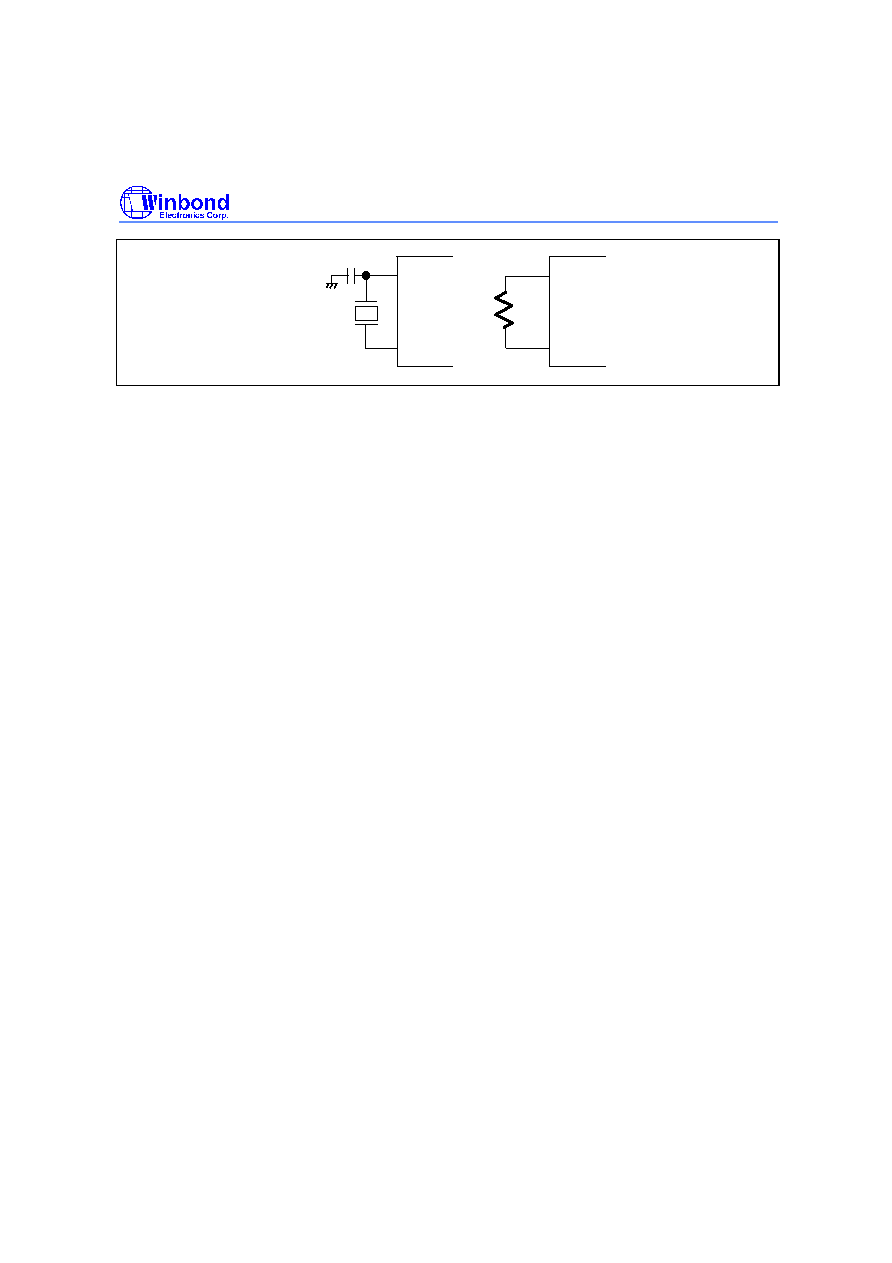
Preliminary W742E81A/W742C81A
- 12 -
XIN1
XOUT1
Crystal
3.58 MHz
or
400 KHz
XIN1
XOUT1
or
Figure 6-3 System Clock Oscillator Configuration
6.8 Sub-Oscillator
The sub-oscillator is used in dual-clock operation mode. In the sub-oscillator application, just only the
32768 Hz crystal could be connected to XIN2 and XOUT2, and it would not be oscillated in STOP
mode.
6.9 Dividers
Each divider is organized as a 14-bit binary up-counter designed to generate periodic interrupts.
When the main oscillator starts action, the Divider0 is incremented by each clock (F
OSC
). When an
overflow occurs, the Divider0 event flag is set to 1 (EVF.0 = 1). Then, if the Divider0 interrupt enable
flag has been set (IEF.0 = 1), the interrupt is executed, while if the hold release enable flag has been
set (HEF.0 = 1), the hold state is terminated. And the last 4-stage of the Divider0 can be reset by
executing CLR DIVR0 instruction.
If the sub-oscillator starts action, the Divider1 is incremented by each clock (Fs in dual-clock mode or
Fosc/128 in single-clock mode). When an overflow occurs, the Divider1 event flag is set to 1 (EVF.4
= 1). Then, if the Divider1 interrupt enable flag has been set (IEF.4 = 1), the interrupt is executed,
while if the hold release enable flag has been set (HEF.4 = 1), the hold state is terminated. And the
last 4-stage of the Divider1 can be reset by executing CLR DIVR1 instruction. Same as EVF.0, the
EVF.4 is set to 1 periodically. But there are two period time (125 mS & 500mS) that can be selected
by setting the SCR.3 bit. When SCR.3 = 0 (default), the 500 mS period time is selected; SCR.3 = 1,
the 125 mS period time is selected.
6.10 Dual-clock operation
This operation mode is selected by option code. In the dual-clock mode, the clock source of the LCD
frequency selector should be the sub-oscillator clock (32768 Hz) only. But in the signal-clock mode,
the clock source of the LCD frequency selector will be Fm/128(Fm : main oscillator clock, See figure
6-4).
So before the STOP instruction is executing, the LCD must be turned off in the signal-
clock mode or dual-clock mode.
In this dual-clock mode, the normal operation is performed by generating the system clock from the
main-oscillator clock (Fm). As required, the slow operation can be performed by generating the
system clock from the sub-oscillator clock (Fs). The exchange of the normal operation and the slow
operation is performed by resetting or setting the bit 0 of the System clock Control Register (SCR). If
the SCR.0 is reset to 0, the clock source of the system clock generator is main-oscillator clock; if the
SCR.0 is set to 1, the clock source of the system clock generator is sub-oscillator clock. In the dual-
clock mode, the main-oscillator can stop oscillating when the STOP instruction is executing or the
SCR.1 is set to 1.
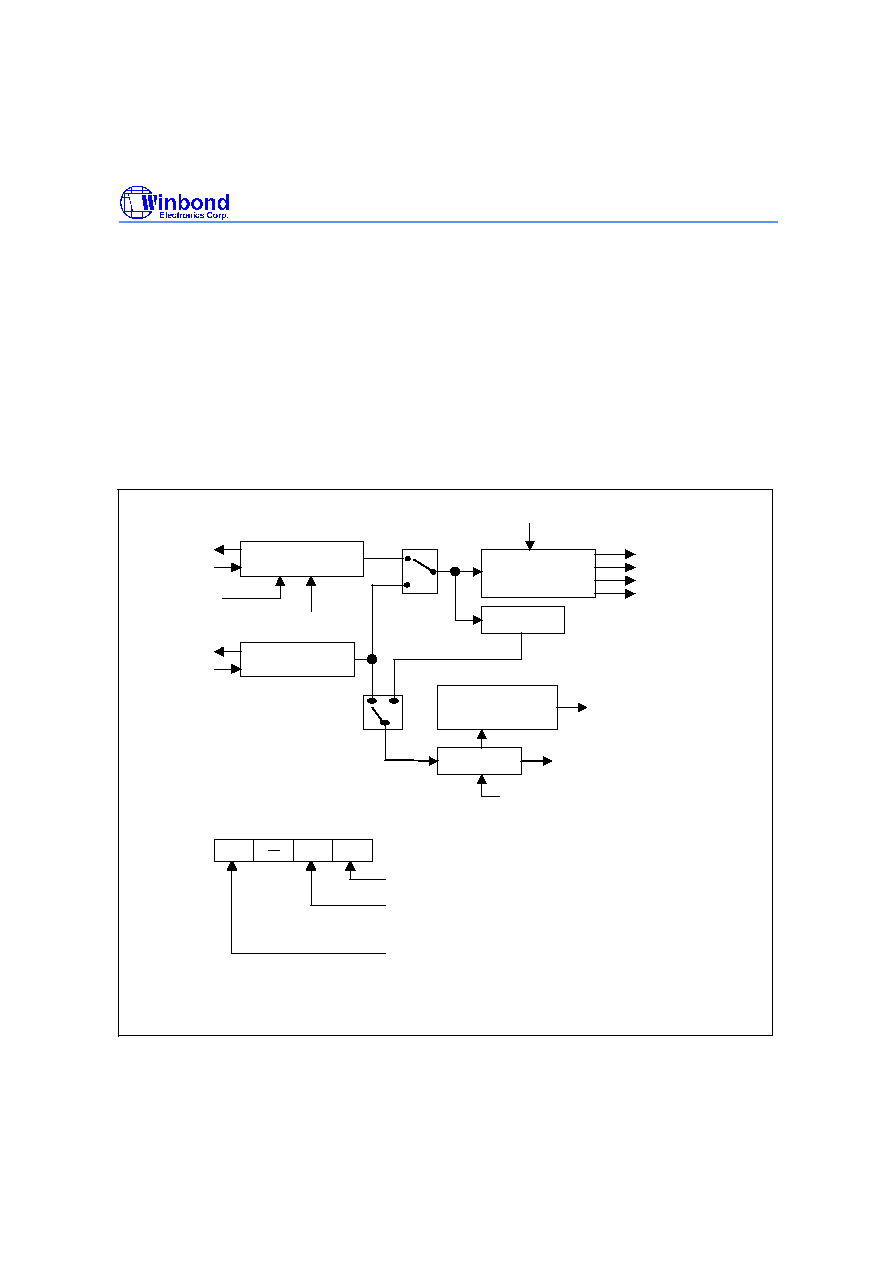
Preliminary W742E81A/W742C81A
Publication Release Date: April 2000
- 13 - Revision A1
When the SCR is set or reset, we must care the following cases:
1. X000B
X011B: we should not exchange the F
OSC
from Fm into Fs and disable Fm
simultaneously. We could first exchange the F
OSC
from Fm into Fs, then disable the main-
oscillator. So it should be X000B
X001B
X011B.
2. X011B
X000B: we should not enable Fm and exchange the F
OSC
from Fs into Fm
simultaneously. We could first enable the main-oscillator; the 2nd step is calling a delay subroutine
to wait the main-oscillator oscillating stably; then exchange the F
OSC
from Fs into Fm is the last
step. So it should be X011B
X001B
delay the Fm oscillating stably time
X000B. The
suggestion of the Fm oscillating stably time is 3.5 mS for 455 KHz and 0.8ms for 4 MHz.
We must remember that the X010B state is inhibitive, because it will induce the system shutdown.
The organization of the dual-clock operation mode is shown in Figure 6-4.
System Clock
Generator
T1
T2
T3
T4
Main Oscillator
XIN1
XOUT1
Sub-Oscillator
XIN2
XOUT2
Fosc
Divider 0
SCR : System clock Control Register ( default = 00H )
Bit0
Bit1
Bit3
0 : Fosc = Fm
1 : Fosc = Fs
0 : Fm enable
1 : Fm disable
Fm
Fs
enable/disable
SCR.1
STOP
HOLD
SCR.0
LCD Frequency
Selector
F
LCD
Divider 1
INT4
HCF.4
SCR.3(14/12 bit)
1 : 12 bit
0 : 14 bit
Daul clock operation mode :
- SCR.0=0, Fosc=Fm : SCR.0=1, Fosc=Fs
- Flcd=Fs, In STOP mode LCD work continue.
Fosc/128
Dual/Single Colck
Option code is 1/0
Fs or Fosc/128
Figure 6-4 Organization of the dual-clock operation mode

Preliminary W742E81A/W742C81A
- 14 -
6.11 WatchDog Timer (WDT) and WatchDog Timer Register(WDTR)
The watchdog timer (WDT) is organized as a 4-bit up counter designed to prevent the program from
unknown errors. When the corresponding option code bit of the WDT set to 1, the WDT is enabled,
and if the WDT overflows, the chip will be reset. At initial reset, the input clock of the WDT is
F
OSC
/2048. The input clock of the WDT can be switched to F
OSC
/16384 (or F
OSC
/2048) by setting
WDTR.3 to 1. The contents of the WDT can be reset by the instruction CLR WDT. In normal
operation, the application program must reset WDT before it overflows. A WDT overflow indicates
that operation is not under control and the chip will be reset. The WDT overflow period is 1 S when
the sub-system clock (Fs) is 32 KHz and WDT clock input is Fs/2048. When the corresponding option
code bit of the WDT set to 0, the WDT function is disabled. The organization of the Divider0 and
watchdog timer is shown in Figure 6-5.
Q1
Q2
Q9
Q10 Q11 Q12
Q14
Q13
Fosc
S
R
Q
HEF.0
IEF.0
1. Reset
2. CLR EVF,#01H
EVF.0
Hold mode release
(HCF.0)
Divider interrupt (INT0)
...
Overflow signal
WDT
Enable
Disable
WDTR.3
Fosc/2048
Fosc/16384
Option code is "0"
Qw1
Qw2
Qw4
Qw3
R
R
R
R
Divider0
System Reset
1. Reset
2. CLR WDT
3. CLR DIVR0
Option code is "1"
WDTR.2
Q1
Q2
Q9
Q10 Q11 Q12
Q14
Q13
S
R
Q
HEF.4
IEF.4
1.
Reset
EVF.4
Hold mode release
(HCF.4)
Divider interrupt
(INT1)
...
Divider1
Fss/2048
Fss/16384
2. CLR EVF,#10H
3. CLR DIVR1
Fss=Fs or Fosc/128
SCR.3
Figure 6-5 Organization of Divider0, Divider1 and WatchDog Timer

Preliminary W742E81A/W742C81A
Publication Release Date: April 2000
- 15 - Revision A1
0
1
2
3
WDTR
R/W
R/W
R/W
R
Note: R/W means read/write available, R means read only.
Power On reset default is : 0000
Bit 3 = 0 F
OSC/
2048(Select Divider0) or Fss/2048(Select Divider1) as the WDT source.
= 1 F
OSC/
16384(Select Divider0) or Fss/16384(Select Divider1) as the WDT source.
Bit 2 = 0 Select Divider0.
= 1 Select Divider1.
Bit 1 = 0 Refer to Table 2.
= 1 Refer to Table 2.
Bit 0 = 0 No time out.
= 1 Time out.
WDTR.0 will be set to one when WDT time out and can be reset to zero by:
Power On Reset, RESET pin, CLR WDT
Table 2 The bit 1 of WatchDog Timer Register (WDTR) reset item
RESET ITEM
WDTR.1 = 1
WDTR.1 = 0
Program Counter (PC)
0000H
0000H
Stack Pointer (SP)
-
Reset
ROMPR, PAGE, DBKR, WRP, ACC, CF, ZF,
SCR registers
-
Reset
IEF, HEF, SEF, HCF, PEF, EVF flags
IEF = Reset
Reset
DIV0, DIV1
-
Reset
TM0, TM1, MR0, MR1 registers
-
Reset
Timer 0 input clock
-
FOSC/4
Timer 1 input clock
-
FOSC
MFP output
-
Low
PM0 register
-
Reset
PM1, PM2, PM5 registers
-
Set (1111B)
PSR0 register
-
Reset
Input/output ports RA, RB, RD
-
Input mode
Output ports RE, RF
-
High
RA, RB ports output type
-
CMOS type
RC port pull-high resistors
-
Disable
Input clock of the watchdog timer
-
FOSC/2048
DTMF output
-
Hi-Z
BUZCR register
-
Reset
FLCD
-
Q5 to Q9 Reset
LCD display
-
OFF
LCDR
-
Reset
Segment output mode
-
LCD drive output
-: keep the status
Note: SCR.2 is reserved

Preliminary W742E81A/W742C81A
- 16 -
6.12 Timer/Counter
6.12.1 Timer 0 (TM0)
Timer 0 (TM0) is a programmable 8-bit binary down-counter. The specified value can be loaded into
TM0 by executing the MOV TM0L(TM0H),R instructions. When the MOV TM0L(TM0H),R instructions
are executed, it will stop the TM0 down-counting (if the TM0 is down-counting) and reset the MR0.3 to
0, and the specified value can be loaded into TM0. Then we can set MR0.3 to 1, that will cause the
event flag 1 (EVF.1) is reset and the TM0 starts to count. When it decreases and underflow to FFH,
Timer 0 stops operating and generates an underflow (EVF.1 = 1). Then, if the Timer 0 interrupt
enable flag has been set (IEF.1 = 1), the interrupt is executed, while if the hold release enable flag 1
has been set (HEF.1 = 1), the hold state is terminated. The Timer 0 clock input can be set as
F
OSC
/1024 or F
OSC
/4 by setting MR0.0 to 1 or resetting MR0.0 to 0. The default timer value is
F
OSC
/4. The organization of Timer 0 is shown in Figure 6-6.
If the Timer 0 clock input is F
OSC
/4:
Desired Timer 0 interval = (preset value +1)
◊
4
◊
1/F
OSC
If the Timer 0 clock input is F
OSC
/1024:
Desired Timer 0 interval = (preset value +1)
◊
1024
◊
1/F
OSC
Preset value: Decimal number of Timer 0 preset value
F
OSC
: Clock oscillation frequency
Fosc/4
Fosc/1024
Enable
Disable
1. Reset
2. CLR EVF,#02H
8-Bit Binary
Down Counter
S
R
Q
HEF.1
IEF.1
Hold mode release (HCF.1)
Timer 0 interrupt (INT1)
1. Reset
2. CLR EVF,#02H
EVF.1
MR0.0
(Timer 0)
Set MR0.3 to 1
3. Reset MR0.3 to 0
3.Set MR0.3 to 1
4
4
MOV TM0H,R
MOV TM0L,R
4.MOV TM0L,R or MOV TM0H,R
Figure 6-6 Organization of Timer 0

Preliminary W742E81A/W742C81A
Publication Release Date: April 2000
- 17 - Revision A1
6.12.2 Timer 1 (TM1)
Timer 1 (TM1) is also a programmable 8-bit binary down counter, as shown in Figure 6-7. Timer 1
can be used as to output an arbitrary frequency to the MFP pin. The input clock of Timer 1 can be
one of three sources: F
OSC
/64, F
OSC
, or Fs. The source can be selected by setting bit 0 and bit 1 of
mode register 1 (MR1). At initial reset, the Timer 1 clock input is F
OSC
. When the MOV TM1L, R or
MOV TM1H,R instruction is executed, the specified data are loaded into the auto-reload buffer; but
the TM1 down-counting will keep going on. If the bit 3 of MR1 is set (MR1.3 = 1), the content of the
auto-reload buffer will be loaded into the TM1 down counter, and Timer 1 starts to down count, and
the event flag 7 is reset (EVF.7 = 0). When the timer decreases and underflow to FFH, it will generate
an underflow (EVF.7 = 1) and be auto-reloaded with the specified data, after which it will continue to
count down. Then, if interrupt enable flag 7 has been set to 1 (IEF.7 = 1), an interrupt is executed; if
hold mode release enable flag 7 is set to 1 (HEF.7 = 1), the hold state is terminated. The specified
frequency of Timer 1 can be delivered to the MFP output pin by programming bit 2 of MR1. Bit 3 of
MR1 can be used to make Timer 1 stop or start counting.
In a case where Timer 1 clock input is F
T
:
Desired Timer 1 interval = (preset value +1) / F
T
Desired frequency for MFP output pin = F
T
˜
(preset value + 1)
˜
2 (Hz)
Preset value: Decimal number of Timer 1 preset value
F
OSC
: Clock oscillation frequency
Auto-reload buffer
8 bits
MR1.3
Underflow signal
EVF.7
MFP
MFP
signal
BUZCR.0
output pin
8-Bit Binary
Down Counter
2
circuit
Reset
Reset
Disable
Enable
Fosc/64
Fosc
MR1.0
(Timer 1)
S
R
Q
1. Reset
2. INT7 accept
3. CLR EVF, #80H
T
F
4. Set MR1.3 to 1
4
4
MOV TM1H,R
MOV TM1L,R
Set
MR1.3 to 1
MR1.1
Fs
MOV WR,TM1
8 bits
Figure 6-7 Organization of Timer 1
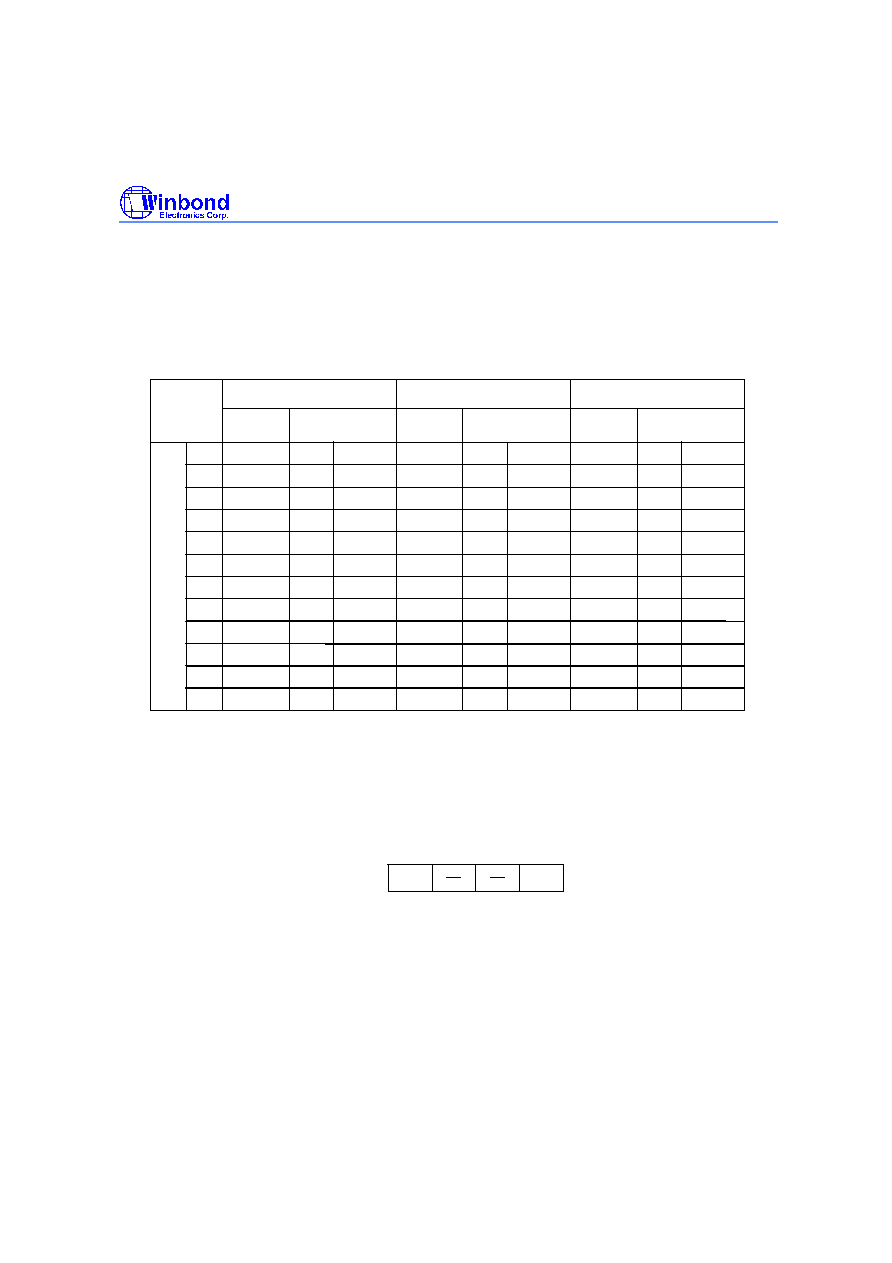
Preliminary W742E81A/W742C81A
- 18 -
For example, when F
T
equals 32768 Hz, depending on the preset value of TM1, the MFP pin will
output a single tone signal in the tone frequency range from 64 Hz to 16384 Hz. The relation between
the tone frequency and the preset value of TM1 is shown in the table below.
MOV WR,TM1 can read back the content of TM1, It will save the TM1 MSB to WR and the TM1 LSB
to ACC.
Table 3 The relation between the tone frequency and the present value of TM1
C
C
#
B
G
F
E
D
A
#
#
D
#
#
G
F
A
E
N
O
T
TM1 preset value
& MFP frequency
3rd octave
4th octave
5th octave
261.63
277.18
293.66
311.13
329.63
349.23
369.99
392.00
415.30
440.00
466.16
493.88
523.25
554.37
587.33
622.25
659.26
698.46
739.99
783.99
830.61
880.00
932.23
987.77
260.06
277.69
292.57
309.13
327.68
372.36
390.09
420.10
443.81
442.81
3EH
3AH
37H
34H
31H
2EH
2BH
29H
26H
22H
24H
20H
468.11
496.48
1EH
1CH
1BH
19H
18H
16H
15H
14H
13H
12H
11H
10H
528.51
564.96
585.14
630.15
655.36
712.34
744.72
780.19
819.20
862.84
910.22
963.76
130.81
138.59
146.83
155.56
164.81
174.61
185.00
196.00
207.65
220.00
233.08
246.94
7CH
75H
6FH
68H
62H
5DH
58H
53H
4EH
45H
49H
41H
131.07
138.84
146.28
156.03
165.49
174.30
184.09
195.04
207.39
221.40
234.05
248.24
Tone
frequency
Tone
frequency
TM1 preset value
& MFP frequency
Tone
frequency
TM1 preset value
& MFP frequency
Note: Central tone is A4 (440 Hz).
6.12.3 Mode Register 0 (MR0)
Mode Register 0 is organized as a 4-bit binary register (MR0.0 to MR0.3). MR0 can be used to control
the operation of Timer 0. The bit descriptions are as follows:
W
W
0
1
2
3
MR0
Note: W means write only.
Bit 0 = 0 The fundamental frequency of Timer 0 is F
OSC
/4.
= 1 The fundamental frequency of Timer 0 is F
OSC
/1024.
Bit 1 & Bit 2 are reserved
Bit 3 = 0 Timer 0 stops down-counting.
= 1 Timer 0 starts down-counting.

Preliminary W742E81A/W742C81A
Publication Release Date: April 2000
- 19 - Revision A1
6.12.4 Mode Register 1 (MR1) & MFP Control Pin (BUZCR)
Mode Register 1 is organized as a 4-bit binary register (MR1.0 to MR1.3). MR1 can be used to control
the operation of Timer 1. The bit descriptions are as follows:
W
W
W
W
0
1
2
3
MR1
Note: W means write only.
Bit 0 = 0 The internal fundamental frequency of Timer 1 is F
OSC
.
= 1 The internal fundamental frequency of Timer 1 is F
OSC
/64.
Bit 1 = 0 The fundamental frequency source of Timer 1 is the internal clock.
= 1 The fundamental frequency source of Timer 1 is the sub-oscillator frequency Fs (32768
Hz).
Bit 2 is reserved.
Bit 3 = 0 Timer 1 stops down-counting.
= 1 Timer 1 starts down-counting.
MFP control pin is organized as a 4-bit binary register.
W
0
1
2
3
BUZCR
Note: W means write only.
Bit 0 = 0 The specified waveform of the MFP generator is delivered to the MFP output pin.
= 1 The specified frequency of Timer 1 is delivered to the MFP output pin.
Bit 1, Bit 2 & Bit 3 are reserved.
6.13 Interrupts
The W742E81A/W742C81A provides four internal interrupt sources (Divider 0, Divider 1, Timer 0,
Timer 1) and one external interrupt source (port RC). Vector addresses for each of the interrupts are
located in the range of program memory (ROM) addresses 004H to 020H. The flags IEF, PEF, and
EVF are used to control the interrupts. When EVF is set to "1" by hardware and the corresponding bits
of IEF and PEF have been set by software, an interrupt is generated. When an interrupt occurs, all of
the interrupts are inhibited until the EN INT or MOV IEF,#I instruction is invoked. The interrupts can
also be disabled by executing the DIS INT instruction. When an interrupt is generated in hold mode,
the hold mode will be released momentarily and interrupt subroutine will be executed. After the RTN
instruction is executed in an interrupt subroutine, the
µ
C will enter hold mode again. The operation
flow chart is shown in Figure 6-9. The control diagram is shown in Figure 6-9.
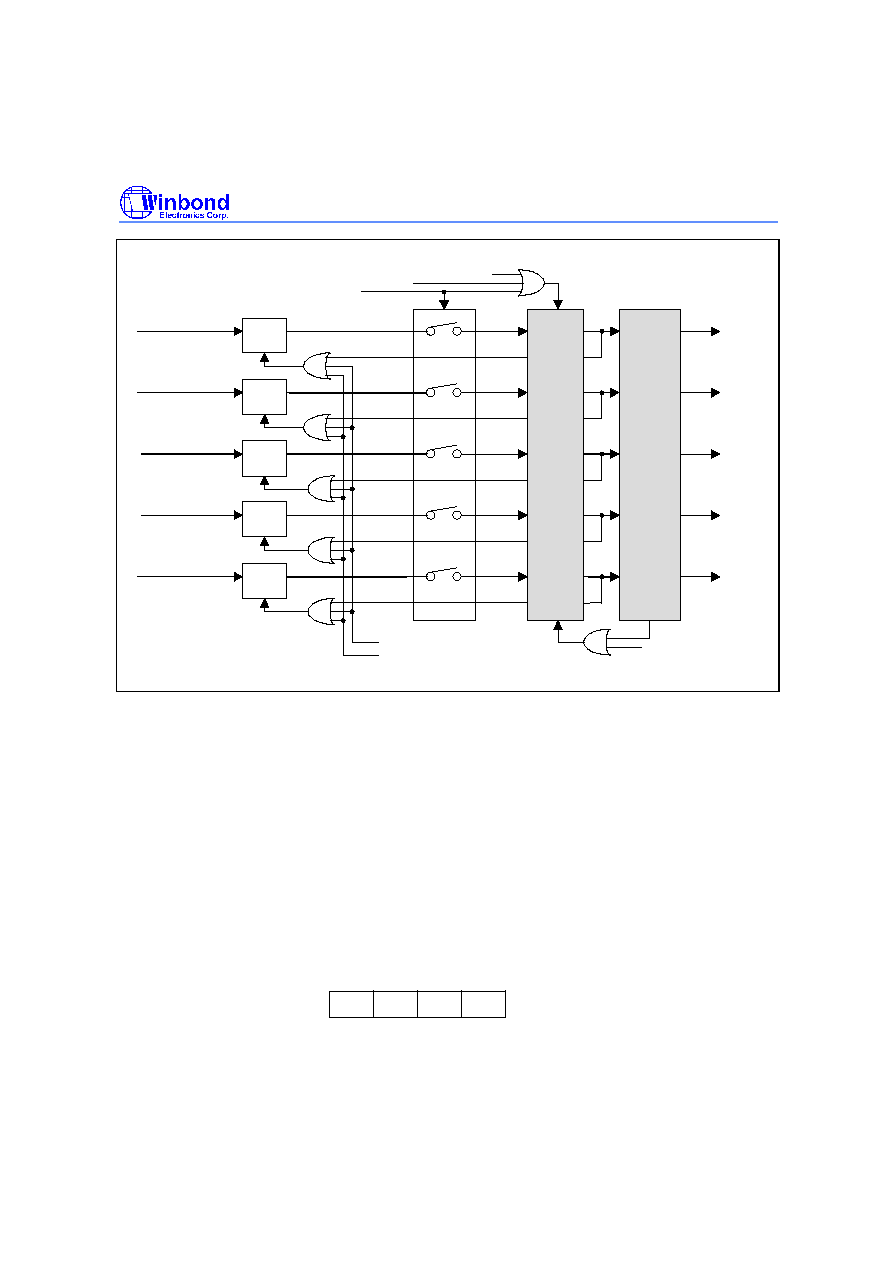
Preliminary W742E81A/W742C81A
- 20 -
S
R
Q
S
R
Q
S
R
Q
IEF.0
IEF.1
Interrupt
Process
Circuit
Interrupt
Vector
Generator
004H
008H
020H
IEF.7
Initial Reset
CLR EVF,#I instruction
DIS INT instruction
Initial Reset
MOV IEF,#I
Enable
EN INT
EVF.1
EVF.0
EVF.7
Disable
Divider 0
overflow signal
Timer 0
underflow signal
Timer 1
underflow signal
S
R
Q
IEF.2
EVF.2
RC port
S
R
Q
IEF.4
EVF.4
overflow signal
signal change
00CH
Divider 1
014H
Figure 6-8 Interrupt event control diagram
6.14 Stop Mode Operation
In stop mode, all operations of the
µ
C cease, and the MFP pin is kept to high. The
µ
C enters stop
mode when the STOP instruction is executed and exits stop mode when an external trigger is
activated (by a falling signal on the RC). When the designated signal is accepted, the
µ
C awakens
and executes the next instruction. To prevent erroneous execution, the NOP instruction should follow
the STOP command. But In the dual-clock slow operation mode, the STOP instruction will also
disable the sub-oscillator oscillating; all operations of the
µ
C cease.
6.14.1 Stop Mode Wake-up Enable Flag for RC Port (SEF)
The stop mode wake-up flag for port RC is organized as an 4-bit binary register (SEF.0 to SEF.3).
Before port RC may be used to make the device exit the stop mode, the content of the SEF must be
set first. The SEF is controlled by the MOV SEF, #I instruction. The bit descriptions are as follows:
SEF
w
w
w
0
1
2
w
3
Note: W means write only.
SEF.0 = 1 Device will exit stop mode when falling edge signal is applied to pin RC.0
SEF.1 = 1 Device will exit stop mode when falling edge signal is applied to pin RC.1

Preliminary W742E81A/W742C81A
Publication Release Date: April 2000
- 21 - Revision A1
SEF.2 = 1 Device will exit stop mode when falling edge signal is applied to pin RC.2
SEF.3 = 1 Device will exit stop mode when falling edge signal is applied to pin RC.3
6.15 Hold Mode Operation
In hold mode, all operations of the
µ
C cease, except for the operation of the oscillator, Timer, Divider,
LCD driver, DTMF generator and MFP generator. The
µ
C enters hold mode when the HOLD
instruction is executed. The hold mode can be released in one of five ways: by the action of timer 0,
timer 1, divider 0, divider 1, the RC port. Before the device enters the hold mode, the HEF, PEF, and
IEF flags must be set to define the hold mode release conditions. For more details, refer to the
instruction-set table and the following flow chart.
Divider 0, Divider 1, Timer
0, Timer 1, Signal Change
at RC Port
In
HOLD
Mode?
IEF
Flag Set?
PC <- (PC+1)
IEF
Flag Set?
No
Yes
No
Yes
Yes
No
Yes
No
HOLD
HEF
Flag Set?
Reset EVF Flag
Execute
Interrupt Service Routine
Reset EVF Flag
Execute
Interrupt Service Routine
Interrupt
Enable?
Interrupt
Enable?
Yes
Yes
No
No
Disable interrupt
Disable interrupt
(Note)
(Note)
Note: The bit of EVF corresponding to the interrupt signal will be reset.
Figure 6-9 Hold Mode and Interrupt Operation Flow Chart
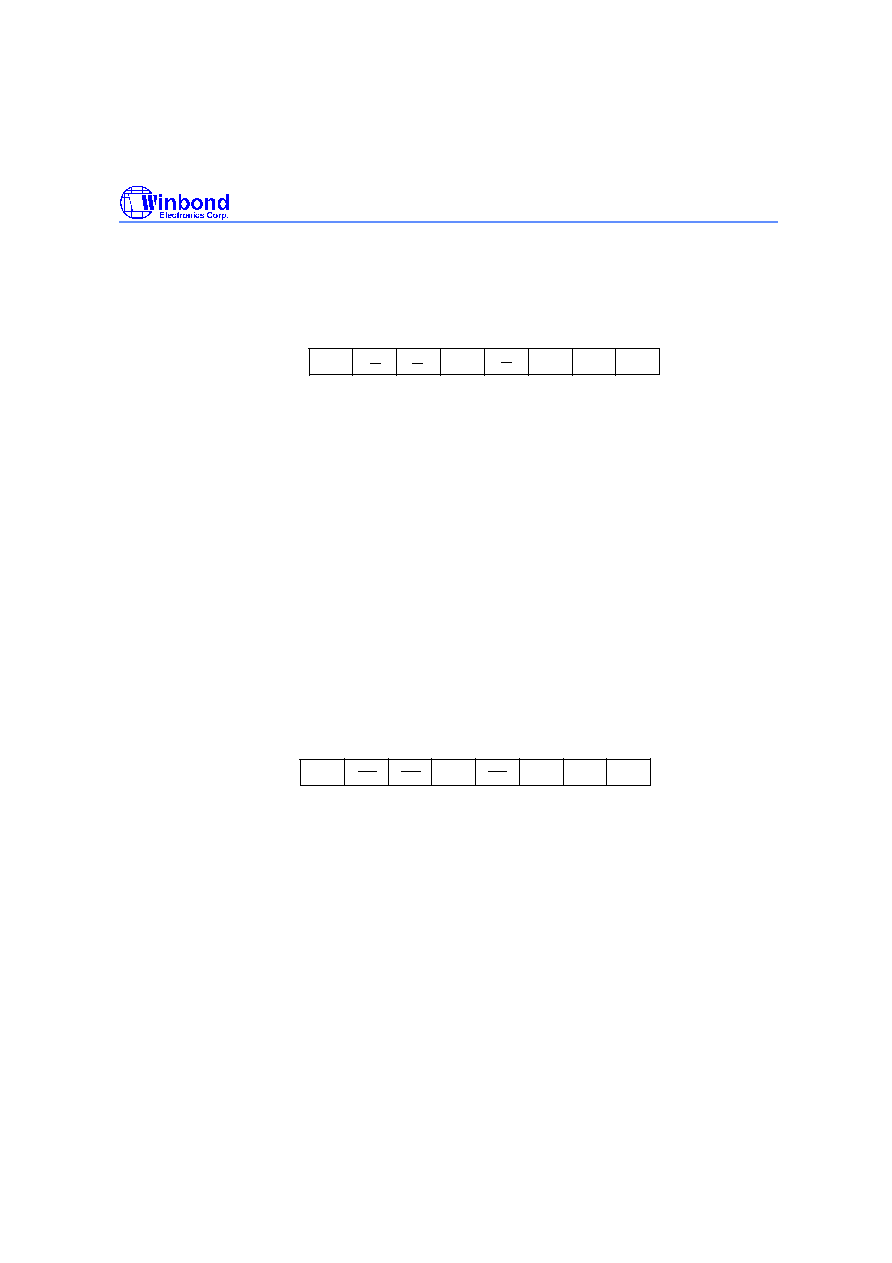
Preliminary W742E81A/W742C81A
- 22 -
6.15.1 Hold Mode Release Enable Flag (HEF)
The hold mode release enable flag is organized as an 8-bit binary register (HEF.0 to HEF.7). The
HEF is used to control the hold mode release conditions. It is controlled by the MOV HEF, #I
instruction. The bit descriptions are as follows:
w
0
1
2
HEF
w
w
w
w
3
4
5
6
7
Note: W means write only.
HEF.0 = 1 Overflow from the Divider 0 causes Hold mode to be released.
HEF.1 = 1 Underflow from Timer 0 causes Hold mode to be released.
HEF.2 = 1 Signal change at port RC causes Hold mode to be released.
HEF.3, HEF.5 & HEF.6 are reserved.
HEF.4 = 1 Overflow from the Divider 1 causes Hold mode to be released.
HEF.7 = 1 Underflow from Timer 1 causes Hold mode to be released.
6.15.2 Interrupt Enable Flag (IEF)
The interrupt enable flag is organized as a 8-bit binary register (IEF.0 to IEF.7). These bits are used
to control the interrupt conditions. It is controlled by the MOV IEF, #I instruction. When one of these
interrupts is accepted, the corresponding to the bit of the event flag will be reset, but the other bits are
unaffected. In interrupt subroutine, these interrupts will be disable till the instruction MOV IEF, #I
or
EN INT
is executed again. Otherwise, these interrupts can be disable by executing DIS INT
instruction. The bit descriptions are as follows:
w
1
2
3
IEF
4
w
w
5
6
0
w
w
7
Note: W means write only.
IEF.0 = 1 Interrupt 0 is accepted by overflow from the Divider 0.
IEF.1 = 1 Interrupt 1 is accepted by underflow from the Timer 0.
IEF.2 = 1 Interrupt 2 is accepted by a signal change at port RC.
IEF.3, IEF.5 & IEF.6 are reserved.
IEF.4 = 1 Interrupt 4 is accepted by overflow from the Divider 1.
IEF.7 = 1 Interrupt 7 is accepted by underflow from Timer 1.
6.15.3 Port Enable Flag (PEF)
The port enable flag is organized as 4-bit binary register (PEF.0 to PEF.3). Before port RC may be
used to release the hold mode or preform interrupt function, the content of the PEF must be set first.
The PEF is controlled by the MOV PEF, #I instruction. The bit descriptions are as follows:
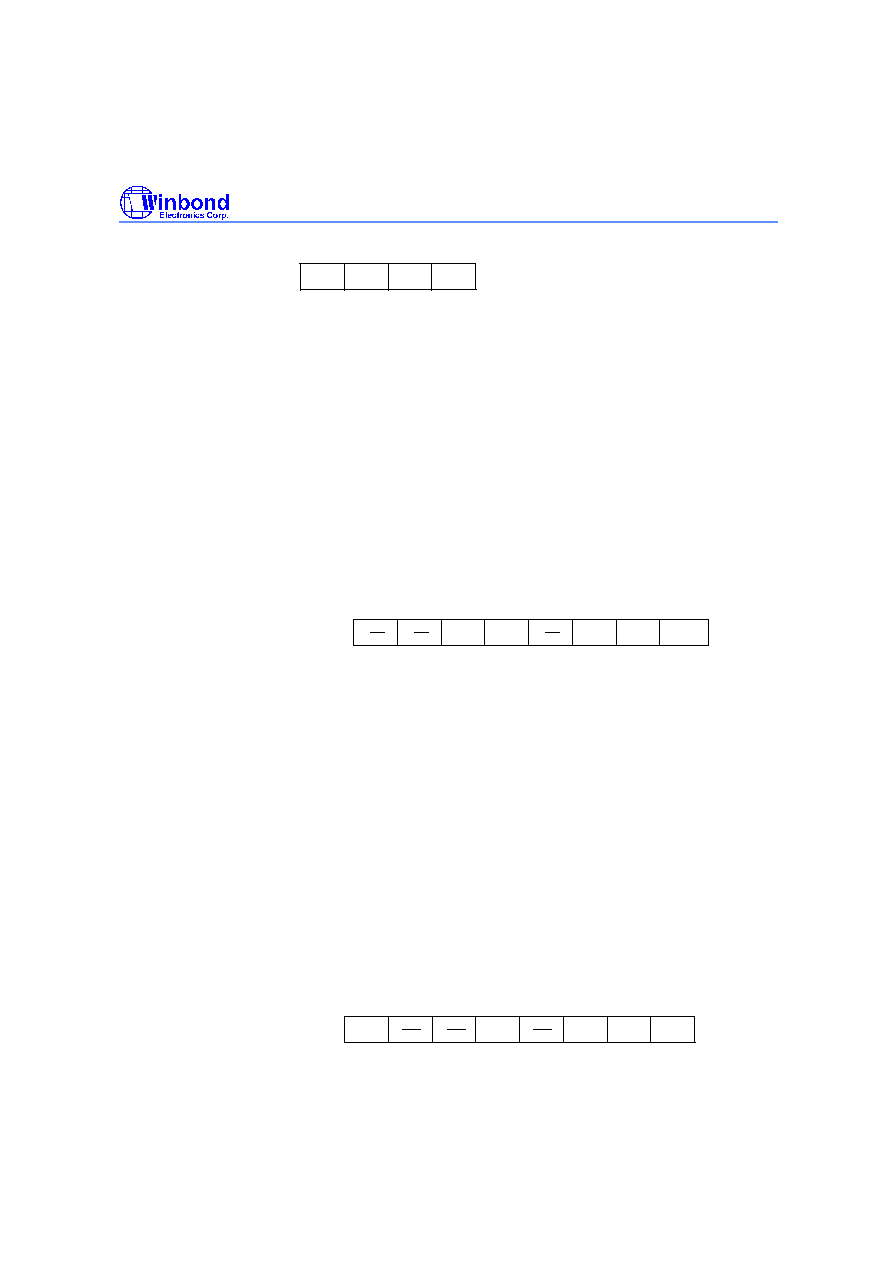
Preliminary W742E81A/W742C81A
Publication Release Date: April 2000
- 23 - Revision A1
PEF
w
w
w
0
1
2
w
3
Note: W means write only.
PEF.0: Enable/disable the signal change at pin RC.0 to release hold mode or perform interrupt.
PEF.1: Enable/disable the signal change at pin RC.1 to release hold mode or perform interrupt.
PEF.2: Enable/disable the signal change at pin RC.2 to release hold mode or perform interrupt.
PEF.3: Enable/disable the signal change at pin RC.3 to release hold mode or perform interrupt.
6.15.4 Hold Mode Release Condition Flag (HCF)
The hold mode release condition flag is organized as a 8-bit binary register (HCF.0 to HCF.7). It
indicates by which interrupt source the hold mode has been released, and is loaded by hardware. The
HCF can be read out by the MOVA R, HCFL
and MOVA R, HCFH instructions. When any of the HCF
bits is "1," the hold mode will be released and the HOLD instruction is invalid. The HCF can be reset
by the CLR EVF or MOV HEF,#I (HEF = 0) instructions. When EVF and HEF have been reset, the
corresponding bit of HCF is reset simultaneously. The bit descriptions are as follows:
R
R
HCF
0
1
2
3
4
5
R
R
R
6
7
Note: R means read only.
HCF.0 = 1 Hold mode was released by overflow from the divider 0.
HCF.1 = 1 Hold mode was released by underflow from the timer 0.
HCF.2 = 1 Hold mode was released by a signal change at port RC.
HCF.3 is reserved.
HCF.4 = 1 Hold mode was released by overflow from the divider 1.
HCF.5 = 1 Hold mode was released by underflow from the timer 1.
HCF.6 and HCF.7 are reserved.
6.15.5 Event Flag (EVF)
The event flag is organized as a 8-bit binary register (EVF.0 to EVF.7). It is set by hardware and reset
by CLR EVF,#I instruction or the occurrence of an interrupt. The bit descriptions are as follows:
R
R
R
EVF
0
1
2
3
4
5
R
R
6
7
Note: R means read only.
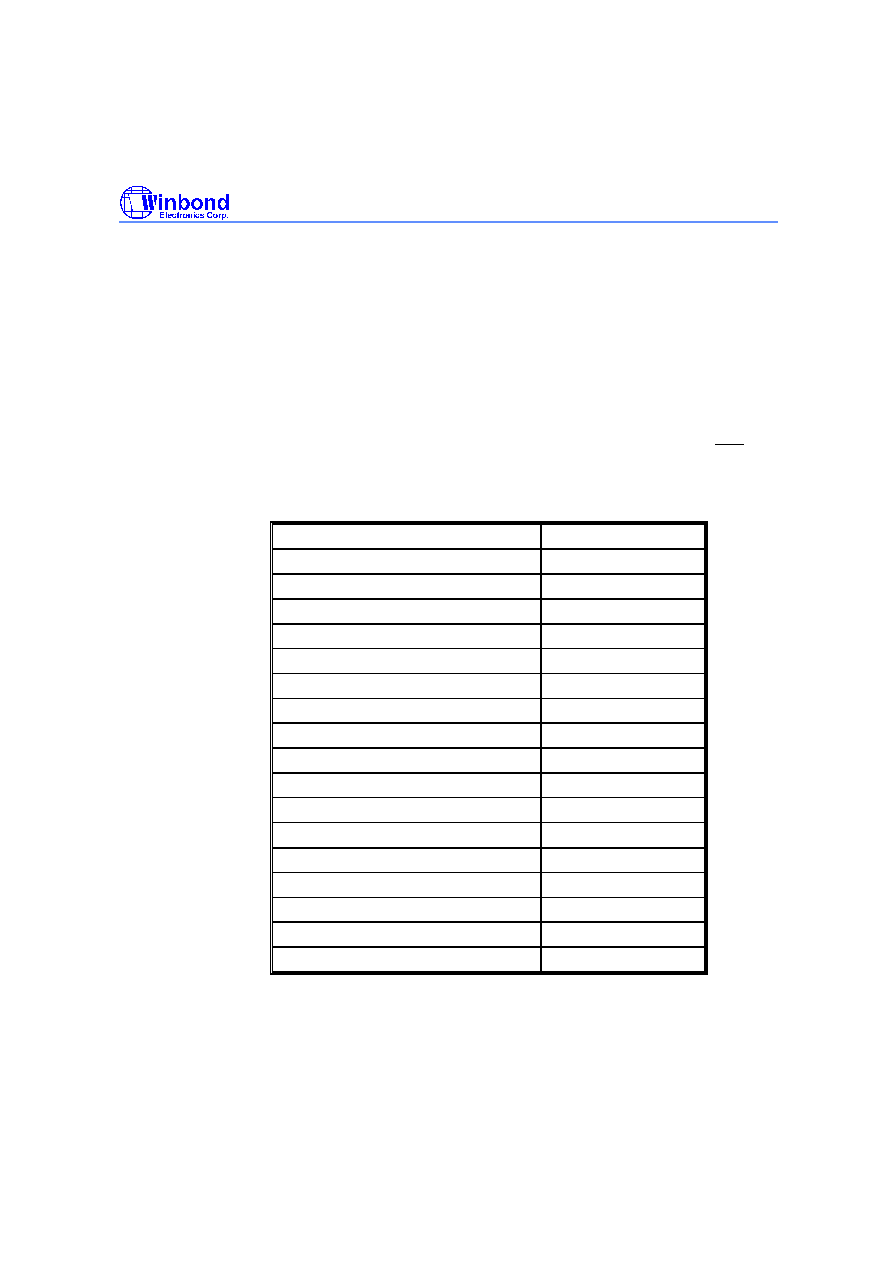
Preliminary W742E81A/W742C81A
- 24 -
EVF.0 = 1 Overflow from divider 0 occurred.
EVF.1 = 1 Underflow from timer 0 occurred.
EVF.2 = 1 Signal change at port RC occurred.
EVF.3 is reserved.
EVF.4 = 1 Overflow from divider 1 occurred.
EVF.5 & EVF.6 are reserved.
EVF.7 = 1 Underflow from Timer 1 occurred.
6.16 Reset Function
The W742E81A/W742C81A is reset either by a power-on reset or by using the external RES pin.
The initial state of the W742E81A/W742C81A after the reset function is executed is described below.
Table 4 The initial state after the reset function is executed
Program Counter (PC)
000H
WDTR registers
Reset
BUZCR registers
Reset
ACC, CF, ZF registers
Reset
MR0, MR1, PAGE registers
Reset
PSR0, SCR, TM0, TM1 registers
Reset
IEF, HEF, HCF, PEF, EVF, SEF flags
Reset
WRP, DBKR, PAGE registers
Reset
Timer 0 input clock
F
OSC
/4
Timer 1 input clock
F
OSC
MFP output
Low
DTMF output
Hi-Z
Input/output ports RA, RB, RD
Input mode
Output port RE & RF
High
RA, RB ports output type
CMOS type
RC ports pull-high resistors
Disable
Input clock of the watchdog timer
F
OSC
/2048
LCD display
OFF
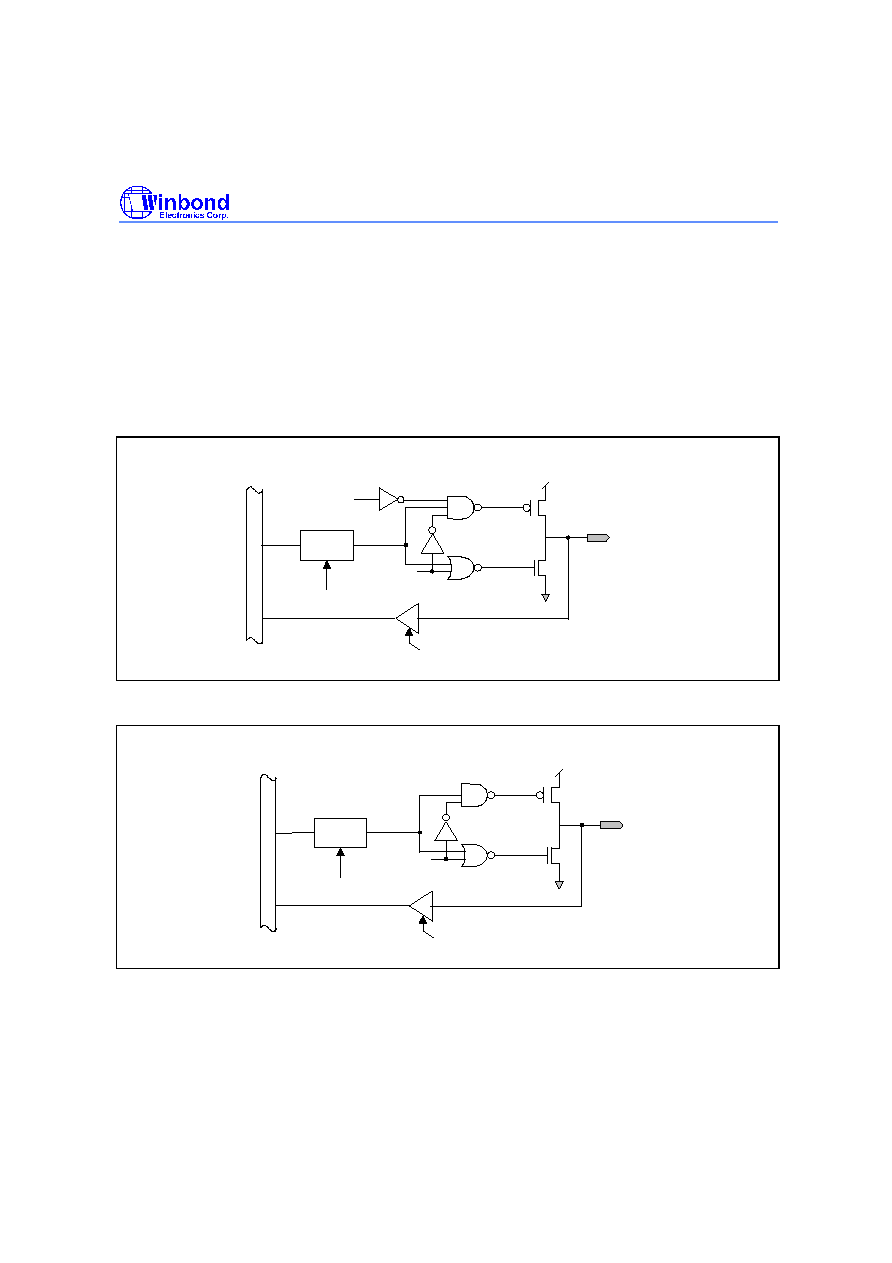
Preliminary W742E81A/W742C81A
Publication Release Date: April 2000
- 25 - Revision A1
6.17 Input/Output Ports RA, RB & RD
Port RA consists of pins RA.0 to RA.3. Port RB consists of pins RB.0 to RB.3. Port RD consists of
pins RD.0 to RD.3. At initial reset, input/output ports RA, RB and RD are all in input mode. When
RA, RB are used as output ports, CMOS or NMOS open drain output type can be selected by the
PM0 register. But when RD is used as output port, the output type is just fixed to be CMOS output
type. Each pin of port RA, RB and RD can be specified as input or output mode independently by the
PM1, PM2 and PM5 registers. The MOVA R, RA or MOVA R, RB or MOVA R, RD instructions
operate the input functions and the MOV RA, R or MOV RB, R or MOV RD, R operate the output
functions. For more details, refer to the instruction table and Figure 6-10 and Figure 6-11.
Input/Output Pin of the RA(RB)
I/O PIN
RA.n(RB.n)
DATA
BUS
Buffer
Output
PM0.0(PM0.1)
PM1.n (PM2.n)
MOVA R,RA(MOVA R,RB) instruction
MOV RA,R(MOV RB,R)
instruction
Enable
Enable
Figure 6-10 Architecture of RA (RB) Input/Output Pins
Input/Output Pin of the RD
I/O PIN
RD.n
DATA
BUS
Buffer
Output
PM5.n
MOVA R,RD instruction
MOV RD,R instruction
Enable
Enable
Figure 6-11 Architecture of RD Input/Output pins
6.17.1 Port Mode 0 Register (PM0)
The port mode 0 register is organized as 4-bit binary register (PM0.0 to PM0.3). PM0 can be used to
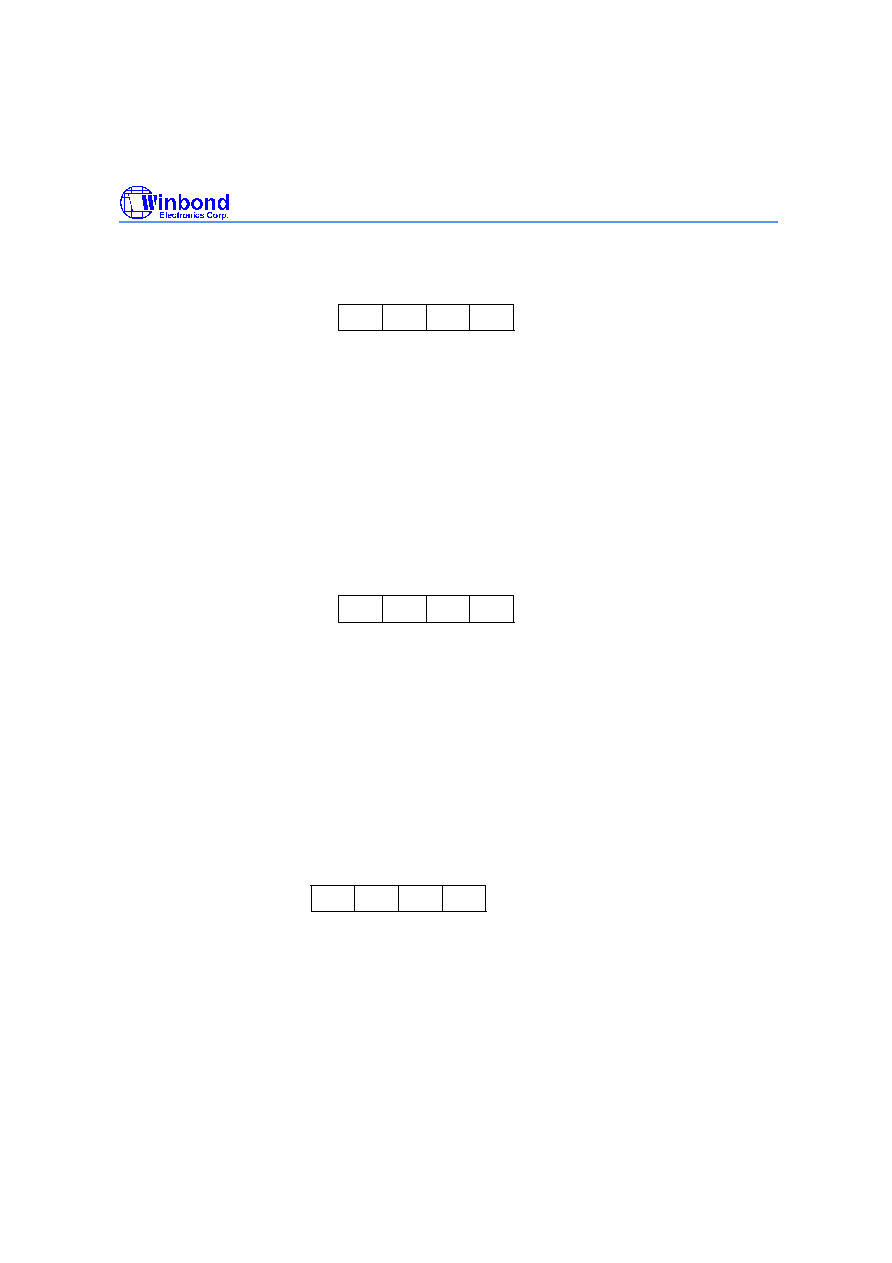
Preliminary W742E81A/W742C81A
- 26 -
determine the structure of the input/output ports; it is controlled by the MOV PM0, #I instruction. The
bit descriptions are as follows:
PM0
w
w
w
0
1
2
w
3
Note: W means write only.
Bit 0 = 0 RA port is CMOS output type. Bit 0 = 1 RA port is NMOS open drain output type.
Bit 1 = 0 RB port is CMOS output type. Bit 1 = 1 RB port is NMOS open drain output type.
Bit 2 = 0 RC port pull-high resistor is disabled. Bit 2 = 1 RC port pull-high resistor is enabled.
Bit 3 is reserved.
6.17.2 Port Mode 1 Register (PM1)
The port mode 1 register is organized as 4-bit binary register (PM1.0 to PM1.3). PM1 can be used to
control the input/output mode of port RA. PM1 is controlled by the MOV PM1, #I instruction. The bit
descriptions are as follows:
PM1
w
w
w
0
1
2
w
3
Note: W means write only.
Bit 0 = 0 RA.0 works as output pin; Bit 0 = 1 RA.0 works as input pin
Bit 1 = 0 RA.1 works as output pin; Bit 1 = 1 RA.1 works as input pin
Bit 2 = 0 RA.2 works as output pin; Bit 2 = 1 RA.2 works as input pin
Bit 3 = 0 RA.3 works as output pin; Bit 3 = 1 RA.3 works as input pin
At initial reset, port RA is input mode (PM1 = 1111B).
6.17.3 Port Mode 2 Register (PM2)
The port mode 2 register is organized as 4-bit binary register (PM2.0 to PM2.3). PM2 can be used to
control the input/output mode of port RB. PM2 is controlled by the MOV PM2, #I instruction. The bit
descriptions are as follows:
PM2
w
w
w
0
1
2
w
3
Note: W means write only.
Bit 0 = 0 RB.0 works as output pin; Bit 0 = 1 RB.0 works as input pin
Bit 1 = 0 RB.1 works as output pin; Bit 1 = 1 RB.1 works as input pin
Bit 2 = 0 RB.2 works as output pin; Bit 2 = 1 RB.2 works as input pin
Bit 3 = 0 RB.3 works as output pin; Bit 3 = 1 RB.3 works as input pin
At initial reset, the port RB is input mode (PM2 = 1111B).

Preliminary W742E81A/W742C81A
Publication Release Date: April 2000
- 27 - Revision A1
6.17.4 Port Mode 5 Register (PM5)
The port mode 5 register is organized as 4-bit binary register (PM5.0 to PM5.3). PM5 can be used to
control the input/output mode of port RD. PM5 is controlled by the MOV PM5, #I instruction. The bit
descriptions are as follows:
PM5
w
w
w
0
1
2
w
3
Note: W means write only.
Bit 0 = 0 RD.0 works as output pin; Bit 0 = 1 RD.0 works as input pin
Bit 1 = 0 RD.1 works as output pin; Bit 1 = 1 RD.1 works as input pin
Bit 2 = 0 RD.2 works as output pin; Bit 2 = 1 RD.2 works as input pin
Bit 3 = 0 RD.3 works as output pin; Bit 3 = 1 RD.3 works as input pin
At initial reset, the port RD is input mode (PM5 = 1111B).
6.18 Input Ports RC
Port RC consists of pins RC.0 to RC.3. Each pin of port RC can be connected to a pull-up resistor,
which is controlled by the port mode 0 register (PM0). When the PEF, HEF, and IEF corresponding to
the RC port are set, a signal change at the specified pins of port RC will execute the hold mode
release or interrupt subroutine. Port status register 0 (PSR0) records the status of ports RC, i.e., any
signal changes on the pins that make up the ports. PSR0 can be read out and cleared by the MOV R,
PSR0, and CLR PSR0 instructions. In addition, the falling edge signal on the pin of port RC specified
by the instruction MOV SEF, #I will cause the device to exit the stop mode
. Refer to Figure 6-12
and the instruction table for more details.
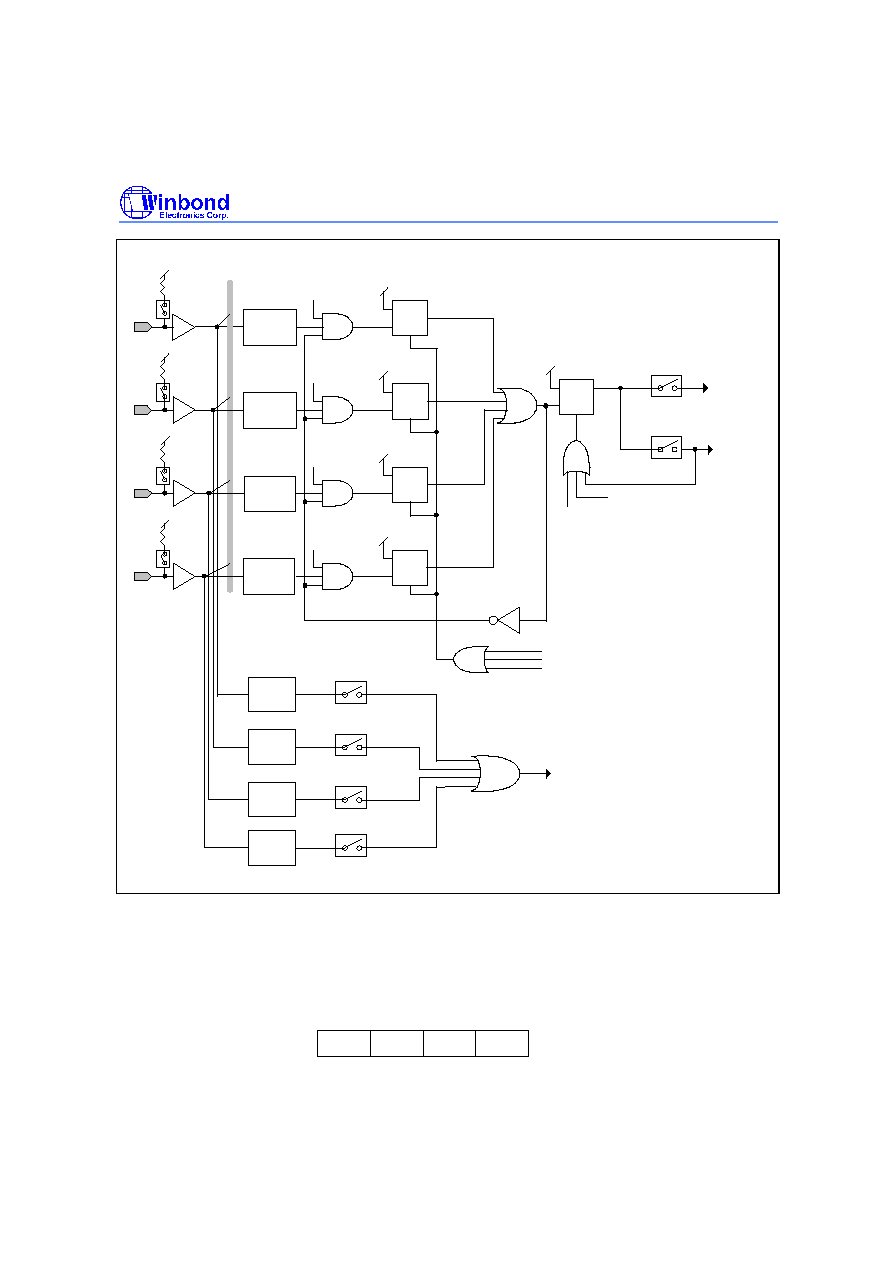
Preliminary W742E81A/W742C81A
- 28 -
Signal
change
detector
PEF.0
D
ck
Q
R
PSR0.0
PSR0.2
D
ck
Q
R
DATA BUS
RC.0
PSR0.3
D
ck
Q
R
PEF.3
Reset
CLR PSR0
HCF.2
INT 2
Reset
CLR EVF, #I
EVF.2
HEF.2
IEF.2
Falling
Edge
detector
Falling
Edge
detector
Falling
Edge
detector
Falling
Edge
detector
SEF.0
SEF.1
SEF.2
SEF.3
To Wake Up Stop Mode
Signal
change
detector
D
ck
Q
R
PSR0.1
RC.1
PEF.1
Signal
change
detector
D
ck
Q
R
PEF.2
RC.2
Signal
change
detector
RC.3
PM0.2
PM0.2
PM0.2
PM0.2
MOV PEF, #I
Figure 6-12 Architecture of Input Ports RC
6.18.1 Port Status Register 0 (PSR0)
Port status register 0 is organized as 4-bit binary register (PSR0.0 to PSR0.3). PSR0 can be read or
cleared by the MOVA R, PSR0, and CLR PSR0 instructions. The bit descriptions are as follows:
R
R
R
R
0
1
2
3
PSR0
Note: R means read only.

Preliminary W742E81A/W742C81A
Publication Release Date: April 2000
- 29 - Revision A1
Bit 0 = 1 Signal change at RC.0
Bit 1 = 1 Signal change at RC.1
Bit 2 = 1 Signal change at RC.2
Bit 3 = 1 Signal change at RC.3
6.19 Output Port RE & RF
Output port RE is used as an output of the internal RT port. When the MOV RE, R instruction is
executed, the data in the RAM will be output to port RT through port RE. It provides a high sink
current to drive an LED. RF port is just used as a output port. When the MOV RF, R instruction is
executed, the data in the RAM will be output to RF.
6.20 DTMF Output Pin (DTMF)
This pin should output the dual tone multi-frequency signal from the DTMF generator. There is the
DTMF register that can specify the wanted low/high frequency. And control whether the dual tone will
be output or not. The tones are divided into two groups (Row group and Col group) and one tone from
each group is selected to represent a digit. The relation between the DTMF signal and the
corresponding touch tone keypad is shown in Figure 6-13.
Row/Col
Frequency
R1
697 Hz
R2
770 Hz
R3
852 Hz
R4
941 Hz
C1
1209 Hz
C2
1336 Hz
C3
1477 Hz
C4
1633 Hz
Figure 6-13 The relation between the touch tone keypad and the frequency
6.20.1 DTMF register
DTMF register is organized as 4-bit binary register. By controlling the DTMF register, one tone of the
low/high group can be selected. The MOV DTMF,R instruction can specify the wanted tones. The bit
descriptions are as follows:
W
W
W
W
0
1
2
3
DTMF
Note: W means write only.
1
2
3
A
4
5
6
B
7
8
9
C
*
0
#
D
R1
R2
R3
R4
C1
C2
C3
C4
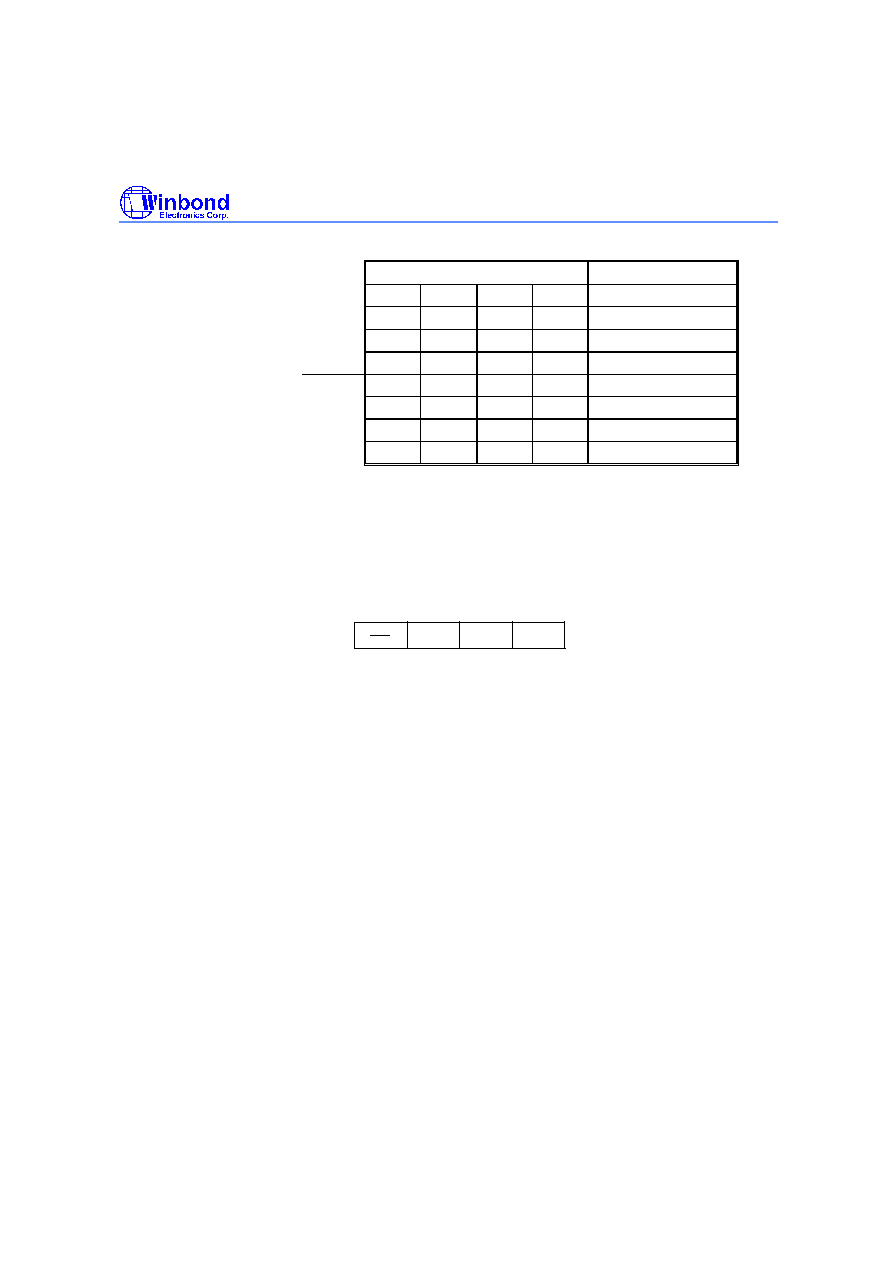
Preliminary W742E81A/W742C81A
- 30 -
B3
B2
B1
B0
SELECTED TONE
X
X
0
0
1209 Hz
High
X
X
0
1
1336 Hz
Group
X
X
1
0
1477 Hz
X
X
1
1
1633 Hz
0
0
X
X
697 Hz
Low
0
1
X
X
770 Hz
Group
1
0
X
X
852 Hz
1
1
X
X
941 Hz
Note: X means this bit do not care.
6.20.2 Dual Tone Control Register (DTCR)
Dual tone control register is organized as 4-bit binary register. The output of the dual or single tone
will be controlled by this register. The MOV DTCR,#I instruction can specify the wanted status. The bit
descriptions are as follows:
W
W
W
0
1
2
3
DTCR
Note: W means write only.
Bit 0 = 1 Low group tone output is enabled.
Bit 1 = 1 High group tone output is enabled.
Bit 2 = 1 DTMF output is enabled. When Bit 2 is reset to 0, the DTMF output pin will be Hi-Z
state.
Bit 3 is reserved.
6.21 MFP Output Pin (MFP)
The MFP output pin can output the Timer 1 clock or the modulation frequency; the output of the pin is
determined by bit 0 of BUZCR (BUZCR.0). The organization of MR1 is shown in Figure 6-7. When
bit 0 of BUZCR is reset to "0," the MFP output can deliver a modulation output in any combination of
one signal from among DC, 4096 Hz, 2048 Hz, and one or more signals from among 128 Hz, 64 Hz,
8 Hz, 4 Hz, 2 Hz, or 1 Hz (when using a 32.768 KHz crystal). The MOV MFP, #I instruction is used to
specify the modulation output combination. The data specified by the 8-bit operand and the MFP
output pin are shown in next page.
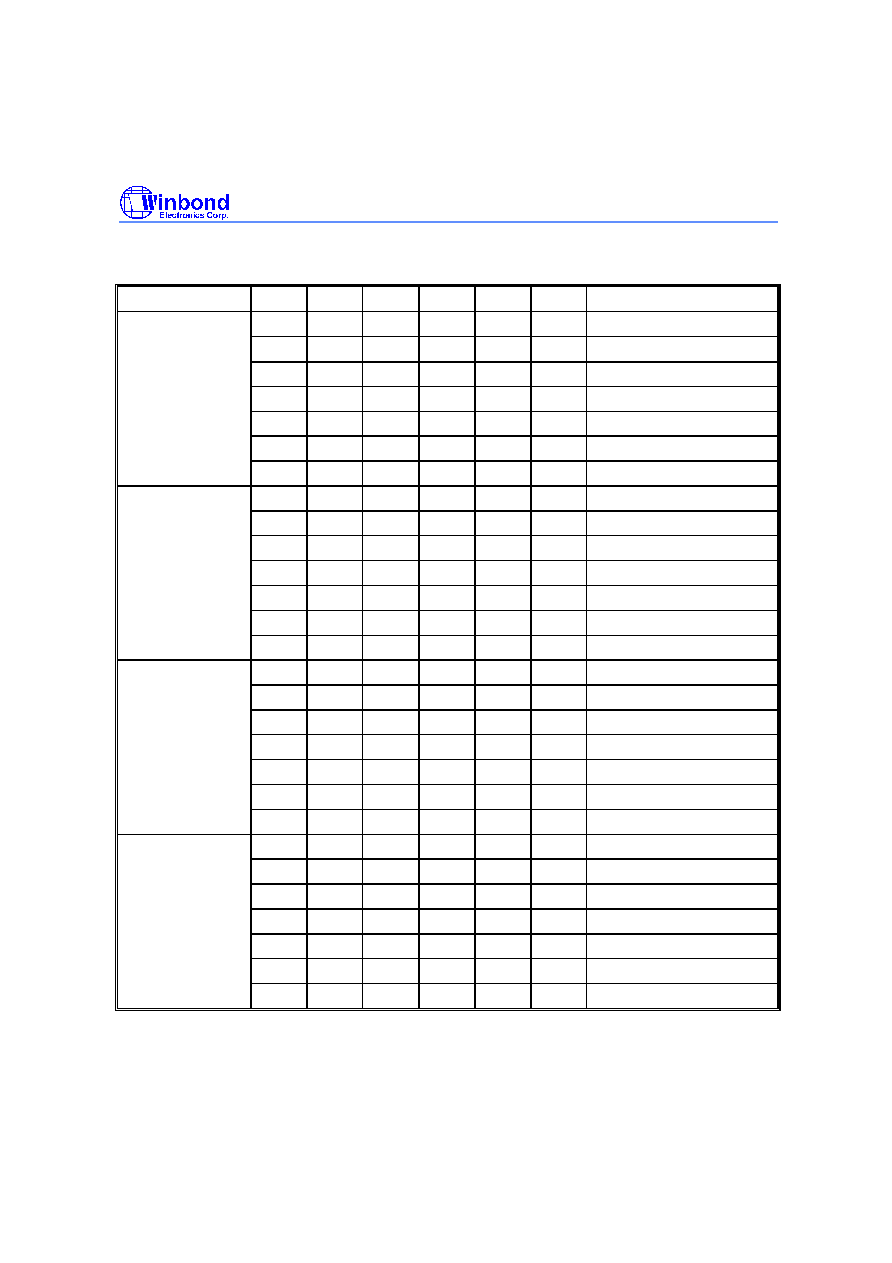
Preliminary W742E81A/W742C81A
Publication Release Date: April 2000
- 31 - Revision A1
Table 5 The relation between the MFP output frequncy and the data specified by 8-bit operand
(Fosc = 32.768 KHz)
R7 R6
R5
R4
R3
R2
R1
R0
FUNCTION
0
0
0
0
0
0
Low level
0
0
0
0
0
1
128 Hz
0
0
0
0
1
0
64 Hz
0 0
0
0
0
1
0
0
8 Hz
0
0
1
0
0
0
4 Hz
0
1
0
0
0
0
2 Hz
1
0
0
0
0
0
1 Hz
0
0
0
0
0
0
High level
0
0
0
0
0
1
128 Hz
0
0
0
0
1
0
64 Hz
0 1
0
0
0
1
0
0
8 Hz
0
0
1
0
0
0
4 Hz
0
1
0
0
0
0
2 Hz
1
0
0
0
0
0
1 Hz
0
0
0
0
0
0
2048 Hz
0
0
0
0
0
1
2048 Hz * 128 Hz
0
0
0
0
1
0
2048 Hz * 64 Hz
1 0
0
0
0
1
0
0
2048 Hz * 8 Hz
0
0
1
0
0
0
2048 Hz * 4 Hz
0
1
0
0
0
0
2048 Hz * 2 Hz
1
0
0
0
0
0
2048 Hz * 1 Hz
0
0
0
0
0
0
4096 Hz
0
0
0
0
0
1
4096 Hz * 128 Hz
0
0
0
0
1
0
4096 Hz * 64 Hz
1 1
0
0
0
1
0
0
4096 Hz * 8 Hz
0
0
1
0
0
0
4096 Hz * 4 Hz
0
1
0
0
0
0
4096 Hz * 2 Hz
1
0
0
0
0
0
4096 Hz * 1 Hz
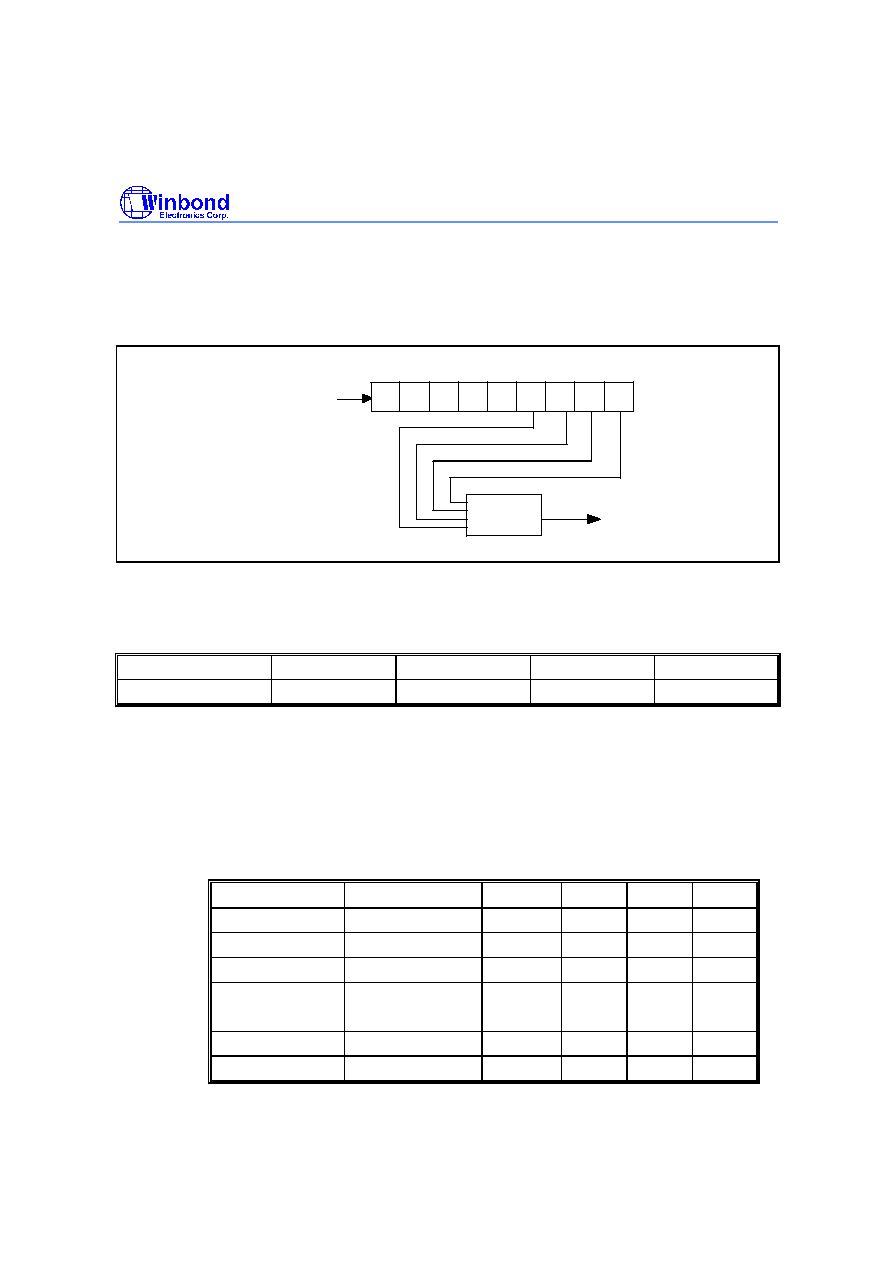
Preliminary W742E81A/W742C81A
- 32 -
6.22 LCD Controller/Driver
The W742E81A/W742C81A can directly drive an LCD with 40 segment output pins and 4 common
output pins for a total of 40
◊
4 dots. The LCD driving mode is 1/3 bias 1/4 duty. The alternating
frequency of the LCD can be set as Fw/64, Fw/128, Fw/256, or Fw/512. The structure of the LCD
alternating frequency (F
LCD
) is shown in the Figure 6-14.
Q1
Q2
Q3
Q4
Q5
Q6
Q7
Q8
Q9
Fw
Selector
Fw/512
Fw/256
Fw/128
Fw/64
Fs or Fosc/128
(By Dual or single
clock Option)
F
LCD
Figure 6-14 LCD alternating frequency (FLCD) circuit diagram
Fw = 32.768 KHz, the LCD frequency is as shown in the table below.
Table 6 The relationship between the FLCD and the duty cycle
LCD FREQUENCY
Fw/64 (512Hz)
Fw/128 (256Hz)
Fw/256 (128Hz)
Fw/512 (64Hz)
1/4 DUTY
128 Hz
64 Hz
32 Hz
16 Hz
Corresponding to the 40 LCD drive output pins, there are 40 LCD data RAM segments. Instructions
such as MOV LPL,R, MOV LPH,R, MOV @LP,R, and MOV R,@LP are used to control the LCD data
RAM. The data in the LCD data RAM are transferred to the segment output pins automatically without
program control. When the bit value of the LCD data RAM is "1," the LCD is turned on. When the bit
value of the LCD data RAM is "0," LCD is turned off. The contents of the LCD data RAM (LCDR) are
sent out through the segment0 to segment39 pins by a direct memory access. The relation between
the LCD data RAM and segment/common pins is shown below.
Table 7 The reation between the LCDR and segment/common pins used as LCD drive output pins
COM3
COM2 COM1 COM0
LCD DATA RAM
OUTPUT PIN
BIT 3
BIT 2
BIT 1
BIT 0
LCDR00
SEG0
0/1
0/1
0/1
0/1
LCDR01
SEG1
0/1
0/1
0/1
0/1
:
:
:
:
:
:
:
:
:
:
:
:
LCDR26
SEG38
0/1
0/1
0/1
0/1
LCDR27
SEG39
0/1
0/1
0/1
0/1
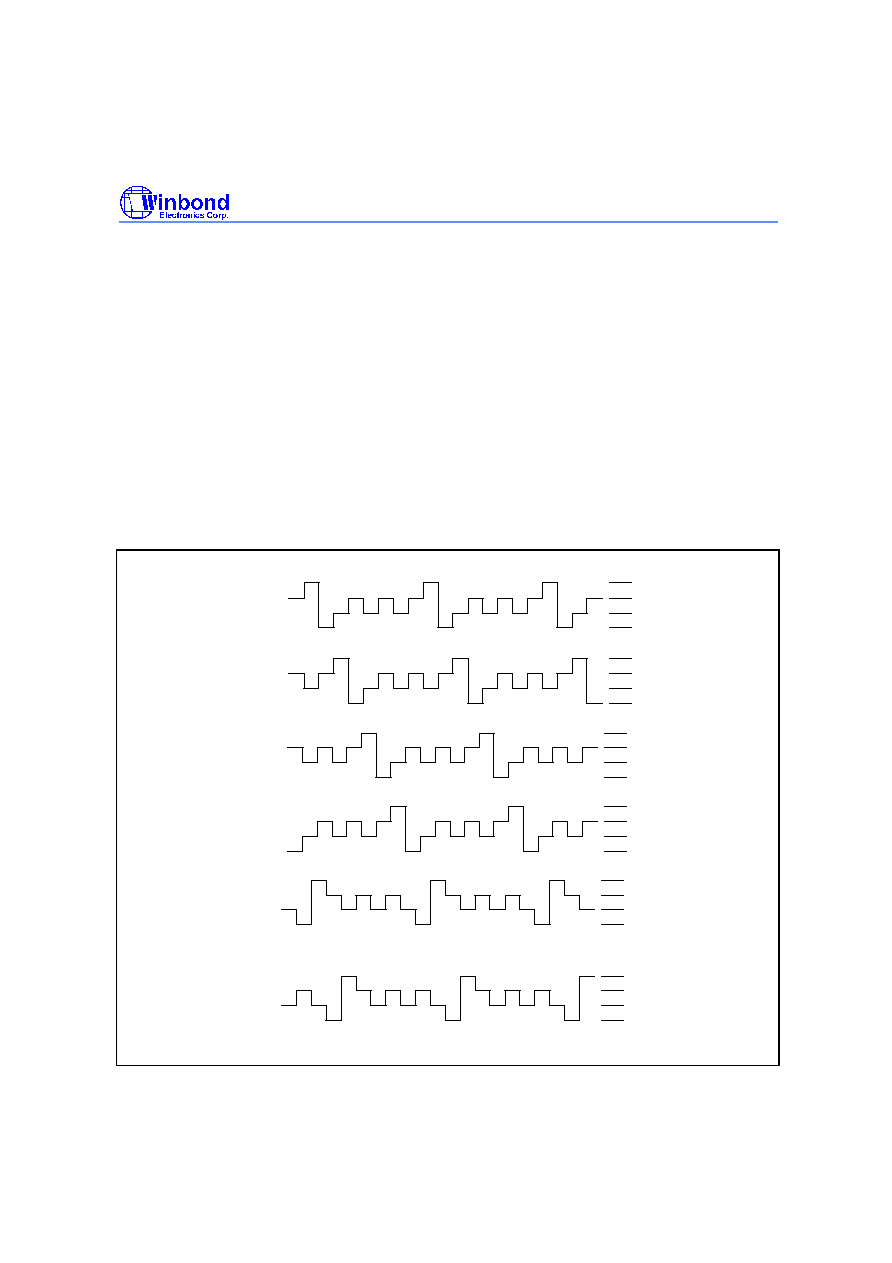
Preliminary W742E81A/W742C81A
Publication Release Date: April 2000
- 33 - Revision A1
The LCDON instruction turns the LCD display on (even in HOLD mode), and the LCDOFF instruction
turns the LCD display off. At initial reset, all the LCD segments are unlit. When the initial reset state
ends, the LCD display is turned off automatically. To turn on the LCD display, the instruction LCDON
must be executed.
6.22.1 LCD RAM addressing method
There are 40 LCD RAMs (LCDR00 - LCDR27) that should be indirectly addressed. The LCD RAM
pointer (LP) is used to point to the address of the wanted LCD RAM. The LP is organized as 6-bit
binary register. The MOV LPL,R and MOV LPH,R instructions can load the LCD RAM address to the
LP from R. The MOV @LP,R and MOV R,@LP instructions can access the pointed LCD RAM
content.
6.22.2 The output waveforms for the LCD driving mode
1/3 bias 1/4 duty Lighting System (Example)
Normal Operating Mode
COM0
VDD2
VDD1
VSS
VDD3
VDD2
VDD1
VSS
VDD3
COM1
COM2
VDD2
VDD1
VSS
VDD3
VDD2
VDD1
VSS
VDD3
COM3
VDD2
VDD1
VSS
VDD3
VDD2
VDD1
VSS
VDD3
LCD driver
outputs for
only seg. on
COM0 side
being lit
LCD driver
outputs for
only seg. on
COM1 side
being lit
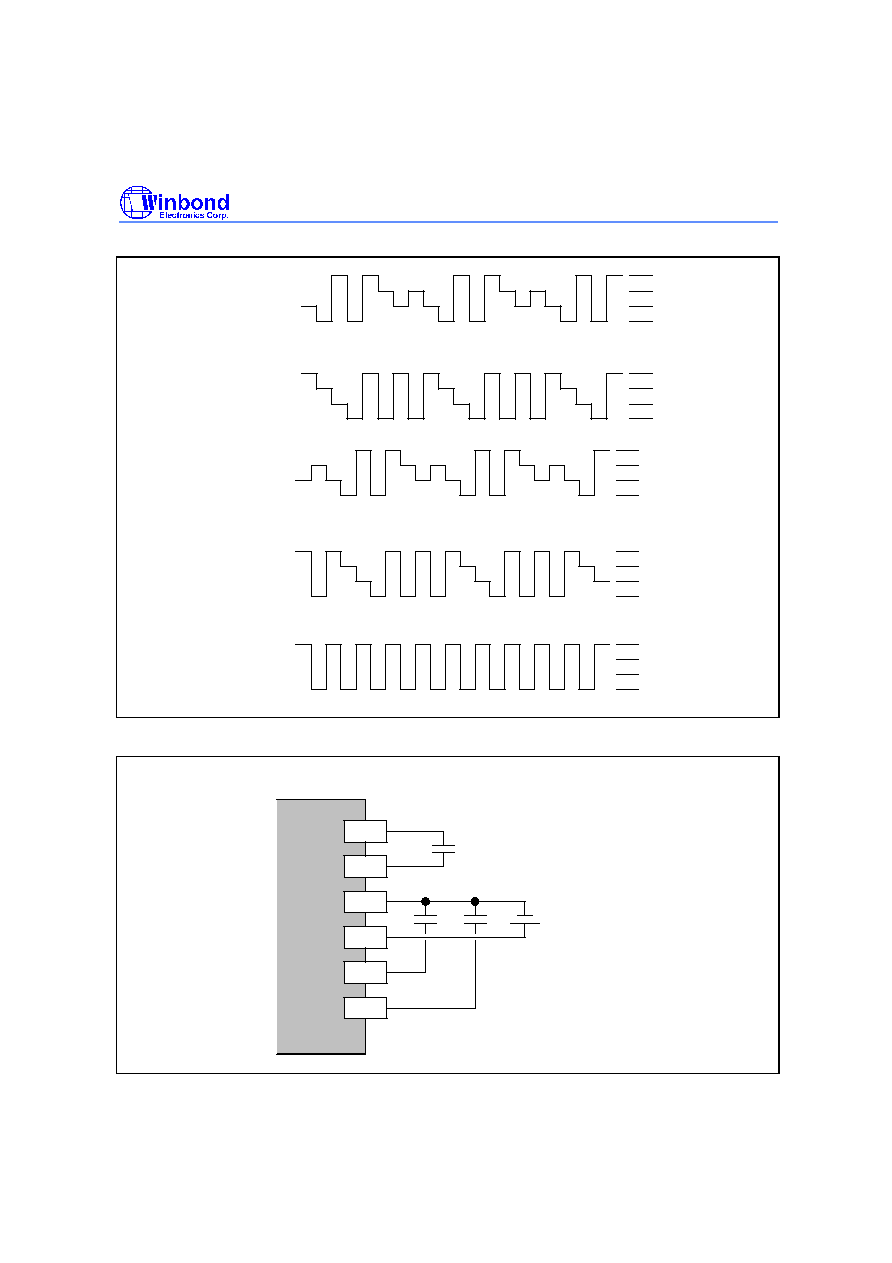
Preliminary W742E81A/W742C81A
- 34 -
Continued
VDD2
VDD1
VSS
VDD3
VDD2
VDD1
VSS
VDD3
LCD driver
outputs for
seg. on COM0,
COM1 sides
being lit
LCD driver
outputs for
seg. on COM1,
COM2,3 sides
being lit
VDD2
VDD1
VSS
VDD3
VDD2
VDD1
VSS
VDD3
LCD driver
outputs for
seg. on COM1
COM2 sides
being lit
LCD driver
outputs for
seg. on COM0
COM2,3 sides
being lit
VDD2
VDD1
VSS
VDD3
LCD driver
outputs for
seg. on COM0
COM1,2,3 sides
being lit
The power connections for the 1/3 bias 1/4 duty LCD driving mode are shown below.
DH1
DH2
VSS
VDD1
VDD
VDD2
0.1uF
0.1uF
VDD = 3.0 V
C
H
I
P
1/3 Bias at VDD = 3.0 V
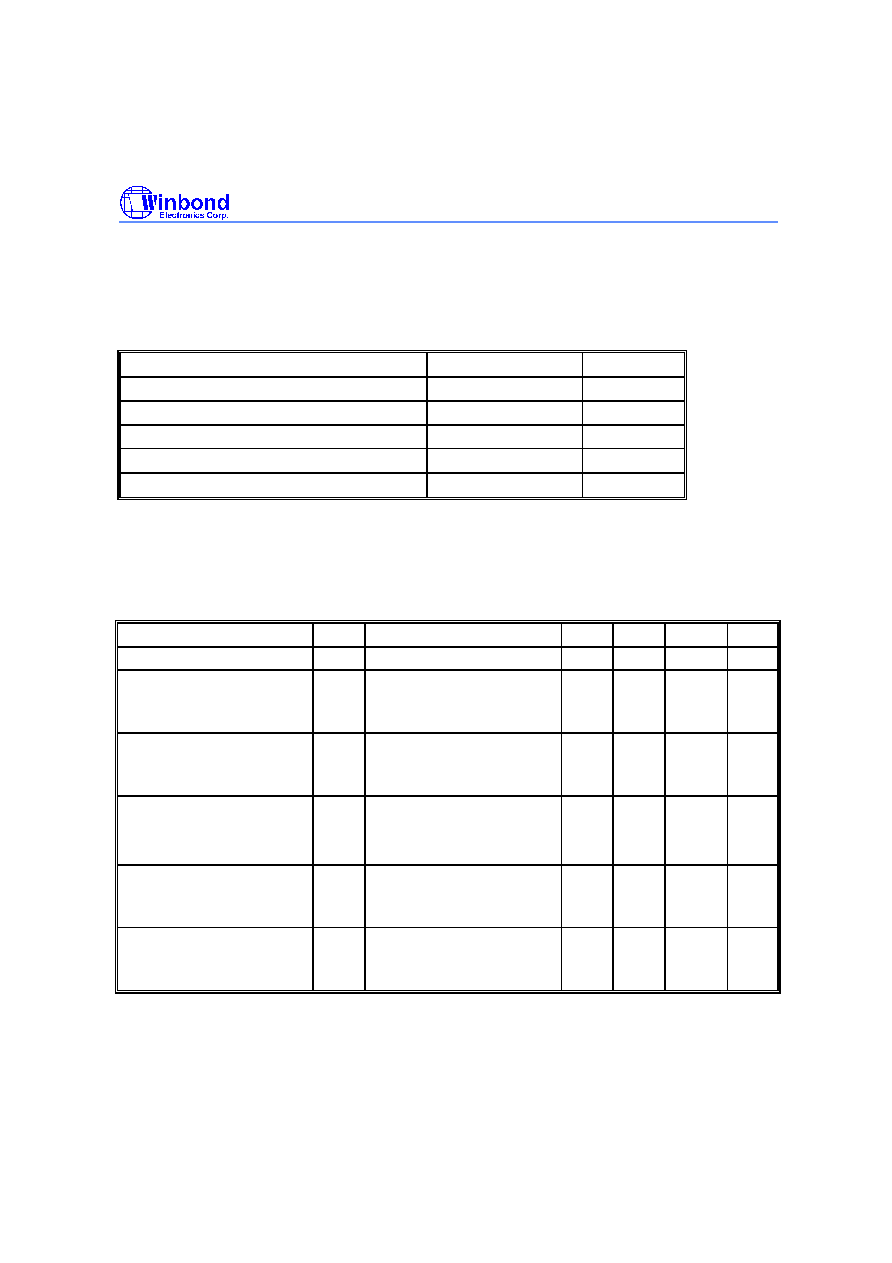
Preliminary W742E81A/W742C81A
Publication Release Date: April 2000
- 35 - Revision A1
6.23 Mode Description
The built-in program code memory of the
W742E81A/W742C81A
is the EEPROM structure. This
memory can be programmed, erased and verified through the VPP, MODE and DATA pins.
7. ABSOLUTE MAXIMUM RATINGS
PARAMETER
RATING
UNIT
Supply Voltage to Ground Potential
-0.3 to +7.0
V
Applied Input/Output Voltage
-0.3 to +7.0
V
Power Dissipation
120
mW
Ambient Operating Temperature
0 to +70
∞
C
Storage Temperature
-55 to +150
∞
C
Note: Exposure to conditions beyond those listed under Absolute Maximum Ratings may adversely affect the life and reliability
of the device.
8. DC CHARACTERISTICS
(V
DD
-V
SS
= 3.0 V, Fm = 3.58 MHz, Fs = 32.768 KHz, T
A
= 25
∞
C, LCD on; unless otherwise specified)
PARAMETER
SYM.
CONDITIONS
MIN. TYP. MAX. UNIT
Op. Voltage
V
DD
-
2.4
-
3.8
V
Op. Current (Crystal type)
I
OP1
No load (Ext-V)
In dual-clock normal
operation
-
0.9
2.5
mA
Op. Current (Crystal type)
I
OP3
No load (Ext-V)
In dual-clock slow operation
and Fm is stopped
-
20
30
µ
A
Hold Current (Crystal type)
I
HM1
Hold mode No load (Ext-V)
In dual-clock normal
operation
-
-
450
µ
A
Hold Current (Crystal type)
I
HM3
Hold mode No load (Ext-V)
In dual-clock slow operation
and Fm is stopped
-
15
30
µ
A
Stop Current (Crystal type)
I
SM1
Stop mode No load (Ext-V)
In dual-clock normal
operation
-
1
2
µ
A
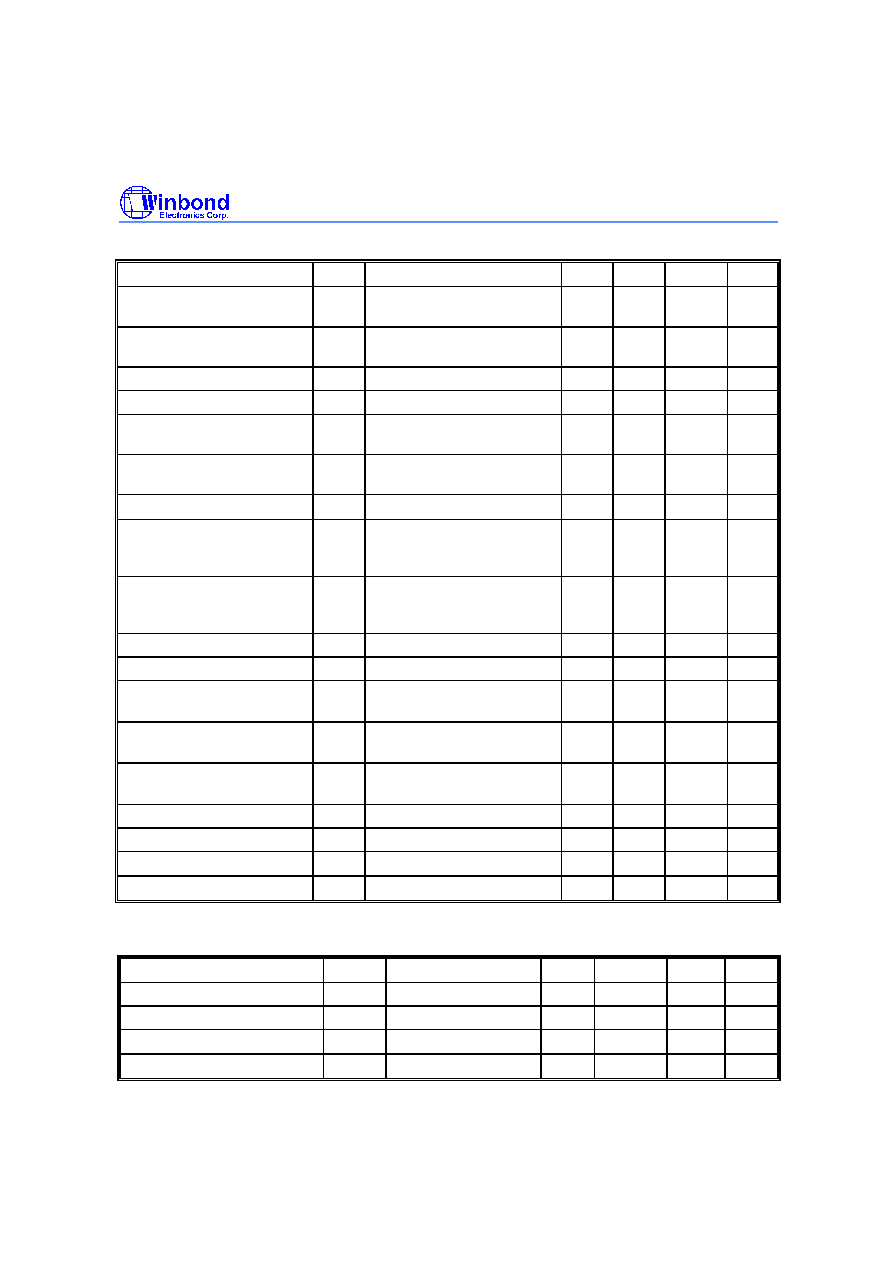
Preliminary W742E81A/W742C81A
- 36 -
DC Characteristics, continued
PARAMETER
SYM.
CONDITIONS
MIN. TYP. MAX. UNIT
Input Low Voltage
V
IL
-
V
SS
-
0.3
V
DD
V
Input High Voltage
V
IH
-
0.7
V
DD
-
V
DD
V
MFP Output Low Voltage
V
ML
I
OL
= 3.5 mA
-
-
0.4
V
MFP Output High Voltage
V
MH
I
OH
= 3.5 mA
2.4
-
-
V
Port RA, RB, RD and RF
Output Low Voltage
V
ABL
I
OL
= 2.0 mA
-
-
0.4
V
Port RA, RB, RD and RF
Output high Voltage
V
ABH
I
OH
= 2.0 mA
2.4
-
-
V
LCD Supply Current
I
LCD
All Seg. ON
-
-
6
µ
A
SEG0-SEG39 Sink
Current (Used as LCD
output)
I
OL1
V
OL
= 0.4V
V
LCD
= 0.0V
90
-
-
µ
A
SEG0-SEG39 Drive
Current
(Used as LCD output)
I
OH1
V
OH
= 2.4V
V
LCD
= 3.0V
90
-
-
µ
A
Port RE Sink Current
I
EL
V
OL
= 0.9V
9
-
-
mA
Port RE Source Current
I
EH
V
OH
= 2.4V
0.4
1.2
-
mA
DTMF Output DC level
V
TDC
R
L
= 5 K
,
V
DD
= 2.5 to 3.8V
1.1
-
2.8
V
DTMF Distortion
T
HD
R
L
= 5 K
,
V
DD
= 2.5 to 3.8V
-
-30
-23
dB
DTMF Output Voltage
V
TO
Low group,
R
L
= 5 K
130
150
170
mVrms
Pre-emphasis
Col/Row
1
2
3
dB
DTMF Output Sink Current
I
TL
V
TO
= 0.5V
0.2
-
-
mA
Pull-up Resistor
R
C
Port RC
100
350
1000
K
RES Pull-up Resistor
R
RES
-
20
100
500
K
9. AC CHARACTERISTICS
PARAMETER
SYM.
CONDITIONS
MIN.
TYP.
MAX. UNIT
Op. Frequency
F
OSC
Crystal type
-
3.58
-
MHz
Instruction Cycle time
T
I
One machine cycle
-
4/F
OSC
-
S
Reset Active Width
T
RAW
F
OSC
= 32.768 KHz
1
-
-
µ
S
Interrupt Active Width
T
IAW
F
OSC
= 32.768 KHz
1
-
-
µ
S

Preliminary W742E81A/W742C81A
Publication Release Date: April 2000
- 37 - Revision A1
10. INSTRUCTION SET TABLE
Symbol Description
ACC:
Accumulator
ACC.n:
Accumulator bit n
WR:
Working Register
WRP:
WR Page Register
PAGE:
Page Register
DBKR:
Data Bank Register
ROMPR:
ROM Page Register
MR0:
Mode Register 0
MR1:
Mode Register 1
PM0:
Port Mode 0
PM1:
Port Mode 1
PM2:
Port Mode 2
PM5:
Port Mode 5
PSR0:
Port Status Register 0
R:
Memory (RAM) of address R
WDTR:
WatchDog Timer Register
LPL:
LCD data RAM pointer
LPH:
LCD data RAM pointer
R.n:
Memory bit n of address R
SCR: System Control Register
BUZCR:
Buzzer Control Register
RA:
I/O Port RA
RC:
I/O Port RC
DTMF:
DTMF Register
DTCR:
MTMF Control Pin
MFP:
MFP Output Pin

Preliminary W742E81A/W742C81A
- 38 -
Symbol Description, continued
I:
Constant parameter
L:
Branch or Jump address
CF:
Carry Flag
ZF:
Zero Flag
PC:
Program Counter
TM0L:
Low nibble of the Timer 0 counter
TM0H:
High nibble of the Timer 0 counter
TM1L:
Low nibble of the Timer 1 counter
TM1H:
High nibble of the Timer 1 counter
TAB0:
Look-up table address buffer 0
TAB1:
Look-up table address buffer 1
TAB2:
Look-up table address buffer 2
TAB3:
Look-up table address buffer 3
IEF.n:
Interrupt Enable Flag n
HCF.n:
HOLD mode release Condition Flag n
HEF.n:
HOLD mode release Enable Flag n
SEF.n:
STOP mode wake-up Enable Flag n
PEF.n:
Port Enable Flag n
EVF.n:
Event Flag n
! =:
Not equal
&:
AND
^:
OR
EX:
Exclusive OR
:
Transfer direction, result
[PAGE*10H+()]:
Contents of address PAGE (bit2, bit1, bit0)*10H+()
[P()]:
Contents of port P
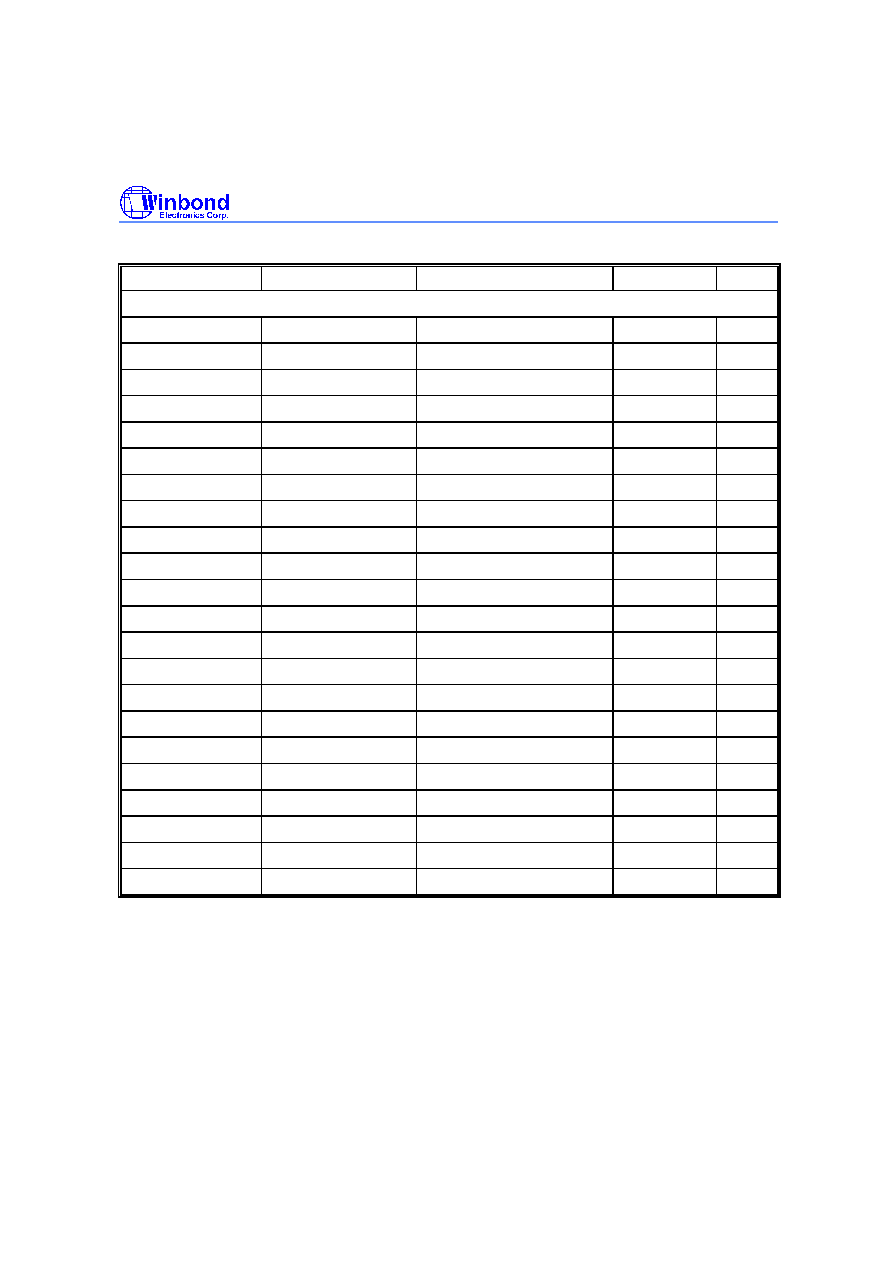
Preliminary W742E81A/W742C81A
Publication Release Date: April 2000
- 39 - Revision A1
Machine code
Mnemonic
Function
Flag affected
W/C
Arithmetic
0001 1000 0xxx xxxx
ADD
R, ACC
ACC
(R) + (ACC)
ZF, CF
1/1
0001 1100 i i i i nnnn
ADD
WRn, #I
ACC
(WRn) + I
ZF, CF
1/1
0001 1001 0xxx xxxx
ADDR
R, ACC
ACC, R
(R) + (ACC)
ZF, CF
1/1
0001 1101 i i i i nnnn
ADDR
WRn, #I
ACC, WRn
(WRn) + I
ZF, CF
1/1
0000 1000 0xxx xxxx
ADC
R, ACC
ACC
(R) + (ACC) + (CF)
ZF, CF
1/1
0000 1100 i i i i nnnn
ADC
WRn, #I
ACC
(WRn) + I + (CF)
ZF, CF
1/1
0000 1001 0xxx xxxx
ADCR
R, ACC
ACC, R
(R) + (ACC) + (CF)
ZF, CF
1/1
0000 1101 i i i i nnnn
ADCR
WRn, #I
ACC, WRn
(WRn) + I + (CF)
ZF, CF
1/1
0010 1000 0xxx xxxx
ADU
R, ACC
ACC
(R) + (ACC)
ZF
1/1
0010 1100 i i i i nnnn
ADU
WRn, #I
ACC
(WRn) + I
ZF
1/1
0010 1001 0xxx xxxx
ADUR
R, ACC
ACC, R
(R) + (ACC)
ZF
1/1
0010 1101 i i i i nnnn
ADUR
WRn, #I
ACC, WRn
(WRn) + I
ZF
1/1
0001 1010 0xxx xxxx
SUB
R, ACC
ACC
(R) - (ACC)
ZF, CF
1/1
0001 1110 i i i i nnnn
SUB
WRn, #I
ACC
(WRn) - I
ZF, CF
1/1
0001 1011 0xxx xxxx
SUBR
R, ACC
ACC, R
(R) - (ACC)
ZF, CF
1/1
0001 1111 i i i i nnnn
SUBR
WRn, #I
ACC, WR
(WR) - I
ZF, CF
1/1
0000 1010 0xxx xxxx
SBC
R, ACC
ACC
(R) - (ACC) - (CF)
ZF, CF
1/1
0000 1110 i i i i nnnn
SBC
WRn, #I
ACC
(WRn) - I - (CF)
ZF, CF
1/1
0000 1011 0xxxxxxx
SBCR
R, ACC
ACC, R
(R) - (ACC) - (CF)
ZF, CF
1/1
0000 1111 i i i i nnnn
SBCR
WRn, #I
ACC, WRn
(WRn) - I - (CF)
ZF, CF
1/1
0100 1010 0xxx xxxx
INC
R
ACC, R
(R) + 1
ZF, CF
1/1
0100 1010 1xxx xxxx
DEC
R
ACC, R
(R) - 1
ZF, CF
1/1
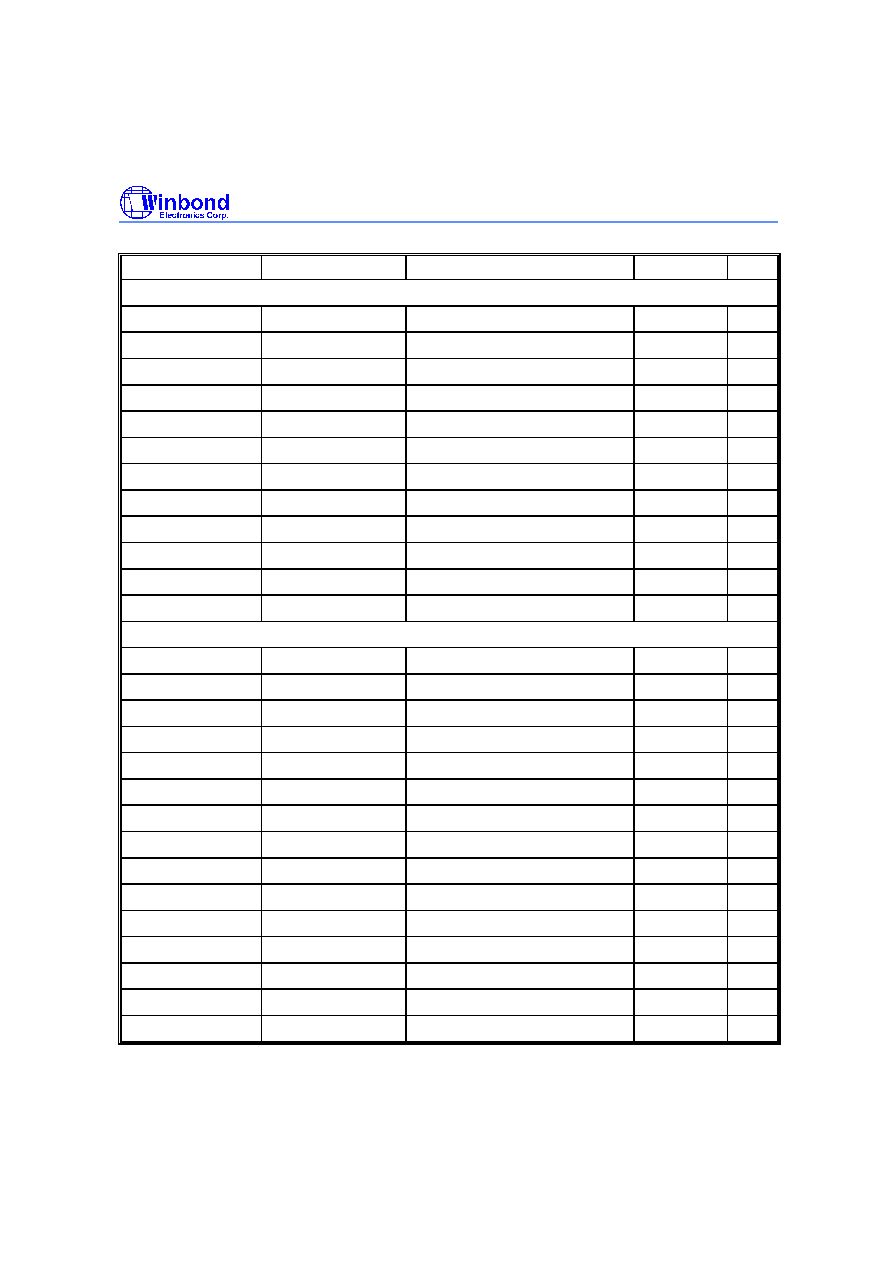
Preliminary W742E81A/W742C81A
- 40 -
Instruction set, continued
Machine code
Mnemonic
Function
Flag affected
W/C
Logic
0010 1010 0xxx xxxx
ANL
R, ACC
ACC
(R) & (ACC)
ZF
1/1
0010 1110 i i i i nnnn
ANL
WRn, #I
ACC
(WRn) & I
ZF
1/1
0010 1011 0xxx xxxx
ANLR
R, ACC
ACC, R
(R) & (ACC)
ZF
1/1
0010 1111 i i i i nnnn
ANLR
WRn, #I
ACC, WRn
(WRn) & I
ZF
1/1
0011 1010 0xxx xxxx
ORL
R, ACC
ACC
(R)
(ACC)
ZF
1/1
0011 1110 i i i i nnnn
ORL
WRn, #I
ACC
(WRn)
I
ZF
1/1
0011 1011 0xxx xxxx
ORLR
R, ACC
ACC, R
(R)
(ACC)
ZF
1/1
0011 1111 i i i i nnnn
ORLR
WRn, #I
ACC, WRn
(WRn)
I
ZF
1/1
0011 1000 0xxx xxxx
XRL
R, ACC
ACC
(R) EX (ACC)
ZF
1/1
0011 1100 i i i i nnnn
XRL
WRn, #I
ACC
(WRn) EX I
ZF
1/1
0011 1001 0xxx xxxx
XRLR
R, ACC
ACC, R
(R) EX (ACC)
ZF
1/1
0011 1101 i i i i nnnn
XRLR
WRn, #I
ACC, WRn
(WRn) EX I
ZF
1/1
Branch
0111 0
aaa aaaa aaaa
JMP
L
PC12~PC0
(ROMPR)
◊
800H+L10~L0
1/1
1000 0
aaa aaaa aaaa
JB0
L
PC10~PC0
L10~L0; if ACC.0 = "1"
1/1
1001 0
aaa aaaa aaaa
JB1
L
PC10~PC0
L10~L0; if ACC.1 = "1"
1/1
1010 0
aaa aaaa aaaa
JB2
L
PC10~PC0
L10~L0; if ACC.2 = "1"
1/1
1011 0
aaa aaaa aaaa
JB3
L
PC10~PC0
L10~L0; if ACC.3 = "1"
1/1
1110 0
aaa aaaa aaaa
JZ
L
PC10~PC0
L10~L0; if ACC = 0
1/1
1100 0
aaa aaaa aaaa
JNZ
L
PC10~PC0
L10~L0; if ACC ! = 0
1/1
1111 0
aaa aaaa aaaa
JC
L
PC10~PC0
L10~L0; if CF = "1"
1/1
1101 0
aaa aaaa aaaa
JNC
L
PC10~PC0
L10~L0; if CF != "1"
1/1
0100 1000 0xxx xxxx
DSKZ
R
ACC, R
(R) - 1; PC
(PC) + 2 if ACC =
0
ZF, CF
1/1
0100 1000 1xxx xxxx
DSKNZ
R
ACC, R
(R) - 1; PC
(PC) + 2 if ACC !=
0
ZF, CF
1/1
1010 1000 0xxx xxxx
SKB0
R
PC
(PC) + 2 if R.0 = "1"
1/1
1010 1000 1xxx xxxx
SKB1
R
PC
(PC) + 2 if R.1 = "1"
1/1
1010 1001 0xxx xxxx
SKB2
R
PC
(PC) + 2 if R.2 = "1"
1/1
1010 1001 1xxx xxxx
SKB3
R
PC
(PC) + 2 if R.3 = "1"
1/1
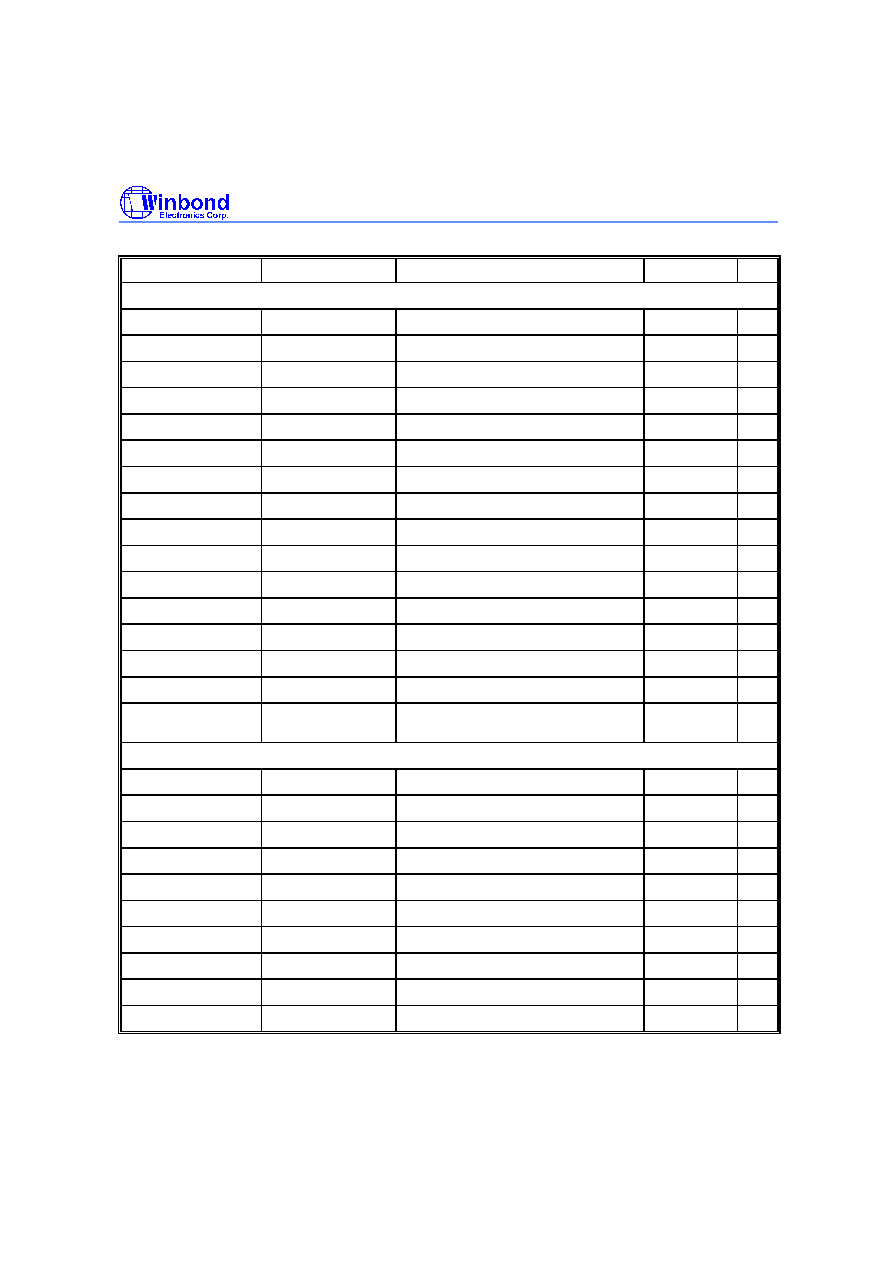
Preliminary W742E81A/W742C81A
Publication Release Date: April 2000
- 41 - Revision A1
Instruction set, continued
Machine code
Mnemonic
Function
Flag affected
W/C
Data move
0001 0000 0000 iiii
MOV
ACC, #I
ACC
I
ZF
1/1
1110 1nnn nxxx xxxx
MOV
WRn, R
WRn
(R)
1/1
1001 1001 iiii nnnn
MOV
WRn, #I
WRn
I
1/1
1111 1nnn nxxx xxxx
MOV
R, WRn
R
(WRn)
1/1
0110 1nnn nxxx xxxx
MOVA
WRn, R
ACC, WRn
(R)
ZF
1/1
0111 1nnn nxxx xxxx
MOVA
R, WRn
ACC, R
(WRn)
ZF
1/1
0101 1001 1xxx xxxx
MOV
R, ACC
R
(ACC)
1/1
0100 1110 1xxx xxxx
MOV
ACC, R
ACC
(R)
ZF
1/1
1011 1i i i i xxx xxxx
MOV
R, #I
R
I
1/1
1100 1nnn n000 qqqq
MOV
WRn, @WRq
WRn
[(DBKR)
◊
80H+(PAGE)x10H +(WRq)]
1/2
1101 1nnn n000 qqqq
MOV
@WRq, WRn
[(DBKR)
◊
80H+(PAGE)x10H +(WRq)]
WRn
1/2
1000 1100 0xxx xxxx
MOV
TAB0, R
TAB0
(R)
1/1
1000 1100 1xxx xxxx
MOV
TAB1, R
TAB1
(R)
1/1
1000 1110 0xxx xxxx
MOV
TAB2, R
TAB2
(R)
1/1
1000 1110 1xxx xxxx
MOV
TAB3, R
TAB3
(R)
1/1
1000 1101 0xxx xxxx
MOVC
R
R
[(TAB3)
◊
1000H+(TAB2)x100H+(TAB1)
x10H + (TAB0)]
1/2
Input & Output
0101 1011 0xxx xxxx
MOVA
R, RA
ACC, R
[RA]
ZF
1/1
0101 1011 1xxx xxxx
MOVA
R, RB
ACC, R
[RB]
ZF
1/1
0100 1011 0xxx xxxx
MOVA
R, RC
ACC, R
[RC]
ZF
1/1
0100 1011 1xxx xxxx
MOVA
R, RD
ACC, R
[RD]
ZF
1/1
0101 1010 0xxx xxxx
MOV
RA, R
[RA]
(R)
1/1
0101 1010 1xxx xxxx
MOV
RB, R
[RB]
(R)
1/1
0100 1010 0xxx xxxx
MOV
RC, R
[RC]
(R)
1/1
1010 1100 1xxx xxxx
MOV
RD, R
[RD]
(R)
1/1
0101 1110 0xxx xxxx
MOV
RE, R
[RE]
(R)
1/1
1010 1110 0xxx xxxx
MOV
RF, R
[RF]
(R)
1/1

Preliminary W742E81A/W742C81A
- 42 -
Instruction set, continued
Machine code
Mnemonic
Function
Flag affected
W/C
Flag & Register
0101 1111 1xxx xxxx
MOVA
R, PAGE
ACC, R
PAGE (Page Register)
ZF
1/1
0101 1110 1xxx xxxx
MOV
PAGE, R
PAGE
(R)
1/1
0101 0110 1000 0i i i
MOV
PAGE, #I
PAGE
I
1/1
1001 1101 1xxx xxxx
MOV
R, WRP
R
WRP
1/1
1001 1100 1xxx xxxx
MOV
WRP, R
WRP
(R)
1/1
0011 0101 1000 i i i i
MOV
WRP, #I
WRP
I
1/1
1001 1101 0000 nnnn
MOV
WRn,DBKR
WRn
DBKR
1/1
1001 1111 0000 nnnn
MOV
WRn,TM1
WRn
TM1.4 - TM1.7, ACC
TM1.0 -
TM1.3
1/1
1001 1100 0000 nnnn
MOV
DBKR, WRn
DBKR
WRn
1/1
0011 0101 0000 ii i i
MOV
DBKR, #I
DBKR
I
1/1
0011 0100 0000 0ii i
MOV
ROMPR, #I
ROMPR
I
1/1
1000 1000 0xxx xxxx
MOV
ROMPR, R
ROMPR
(R)
1/1
1000 1001 0xxx xxxx
MOV
R, ROMPR
R
(ROMPR)
1/1
0101 1001 0xxx xxxx
MOVA
R, CF
ACC.0, R.0
CF
ZF
1/1
0101 1000 0xxx xxxx
MOV
CF, R
CF
(R.0)
CF
1/1
0100 1001 0xxx xxxx
MOVA
R, HCFL
ACC, R
HCF.0~HCF.3
ZF
1/1
0100 1001 1xxx xxxx
MOVA
R, HCFH
ACC, R
HCF.4~HCF.7
ZF
1/1
0101 0011 0000 i i i i
MOV
PM0, #I
Port Mode 0
I
1/1
0101 0111 0000 i i i i
MOV
PM1, #I
Port Mode 1
I
1/1
0101 0111 1000 i i i i
MOV
PM2, #I
Port Mode 2
I
1/1
0011 0111 1000 i i i i
MOV
PM5, #I
Port Mode 5
I
1/1
0100 0000 i00i 0i i i
CLR
EVF, #I
Clear Event Flag if In = 1
1/1
0101 1101 0xxx xxxx
MOVA
R, EVFL
R
EVF.0 - EVF.3
1/1
0101 1101 1xxx xxxx
MOVA
R, EVFH
R
EVF.4 - EVF.7
1/1
0100 0001 i00i 0i i i
MOV
HEF, #I
Set/Reset HOLD mode release Enable Flag
1/1
0101 0001 i00i 0i i i
MOV
IEF, #I
Set/Reset Interrupt Enable Flag
1/1
0100 0011 0000 i i i i
MOV
PEF, #I
Set/Reset Port Enable Flag
1/1
0101 0010 0000 i i i i
MOV
SEF, #I
Set/Reset STOP mode wake-up Enable Flag
for RC port
1/1
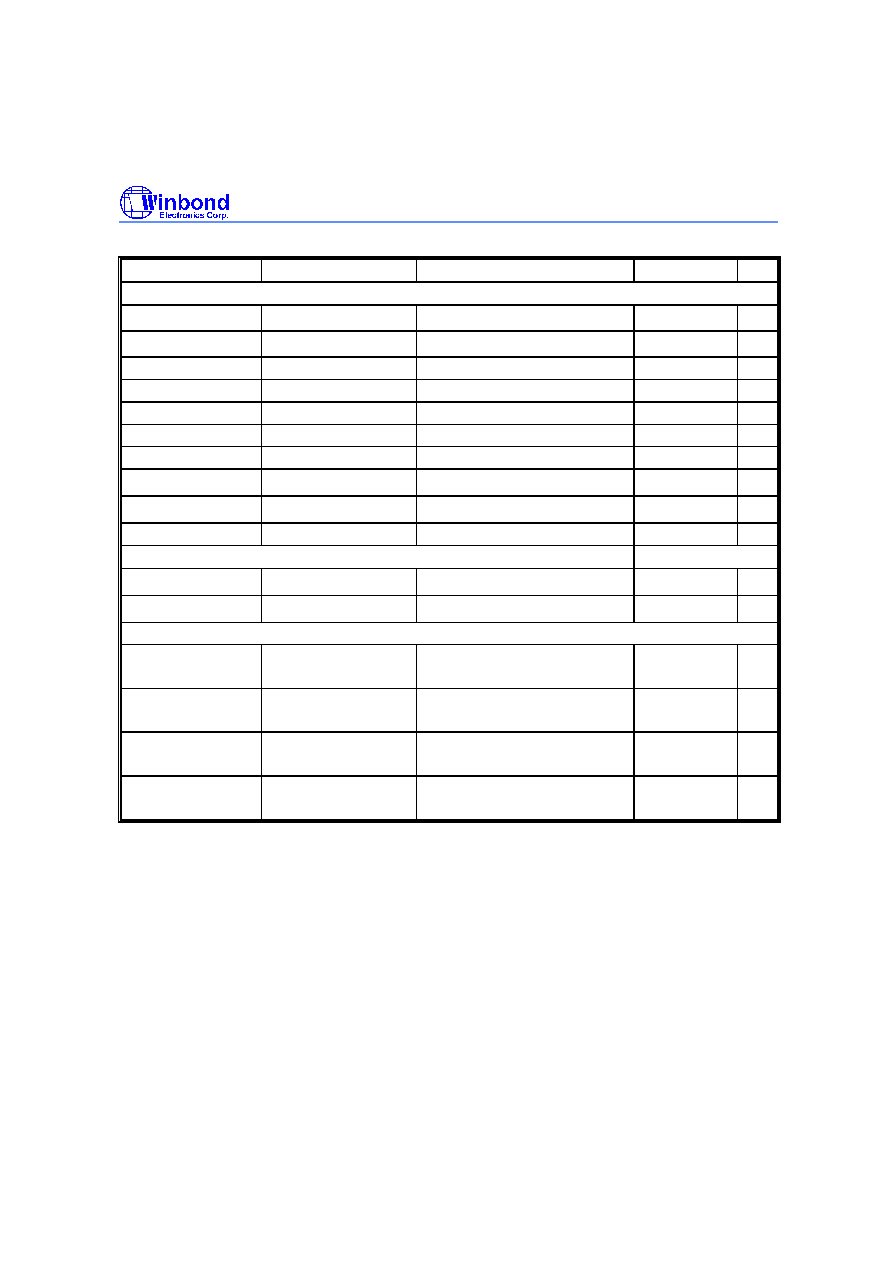
Preliminary W742E81A/W742C81A
Publication Release Date: April 2000
- 43 - Revision A1
Instruction set, continued
Machine code
Mnemonic
Function
Flag affected
W/C
Flag & Register
0101 0100 0000 i 0 i i
MOV
SCR, #I
SCR
I
1/1
0100 1111 0xxx xxxx
MOVA
R, PSR0
ACC, R
Port Status Register 0
ZF
1/1
0100 0010 0000 0000
CLR
PSR0
Clear Port Status Register 0
1/1
0101 0000 0100 0000
SET
CF
Set Carry Flag
CF
1/1
0101 0000 0000 0000
CLR
CF
Clear Carry Flag
CF
1/1
0001 0111 0000 0000
CLR
DIVR0
Clear the last 4-bit of the Divider 0
1/1
0101 0101 1000 0000
CLR
DIVR1
Clear the last 4-bit of the Divider 1
1/1
0101 0110 0000 i i i i
MOV
WDTR, #I
WDTR
I
1/1
0101 1111 0xxx xxxx
MOVA
R,WDTR
ACC, R
Watchdog Timer Register
1/1
0001 0111 1000 0000
CLR
WDT
Clear Watchdog Timer
1/1
DTMF
1001 1110 1xxx xxxx
MOV
DTMF,R
DTMF
(R)
1/1
0011 0100 1000 0iii
MOV
DTCR,I
DTCR
I
1/1
Shift & Rotate
0100 1101 0xxx xxxx
SHRC
R
ACC.n, R.n
(R.n+1);
ACC.3, R.3
0; CF
R.0
ZF, CF
1/1
0100 1101 1xxx xxxx
RRC
R
ACC.n, R.n
(R.n+1);
ACC.3, R.3
CF; CF
R.0
ZF, CF
1/1
0100 1100 0xxx xxxx
SHLC
R
ACC.n, R.n
(R.n-1);
ACC.0, R.0
0; CF
R.3
ZF, CF
1/1
0100 1100 1xxx xxxx
RLC
R
ACC.n, R.n
(R.n-1);
ACC.0, R.0
CF; CF
R.3
ZF, CF
1/1
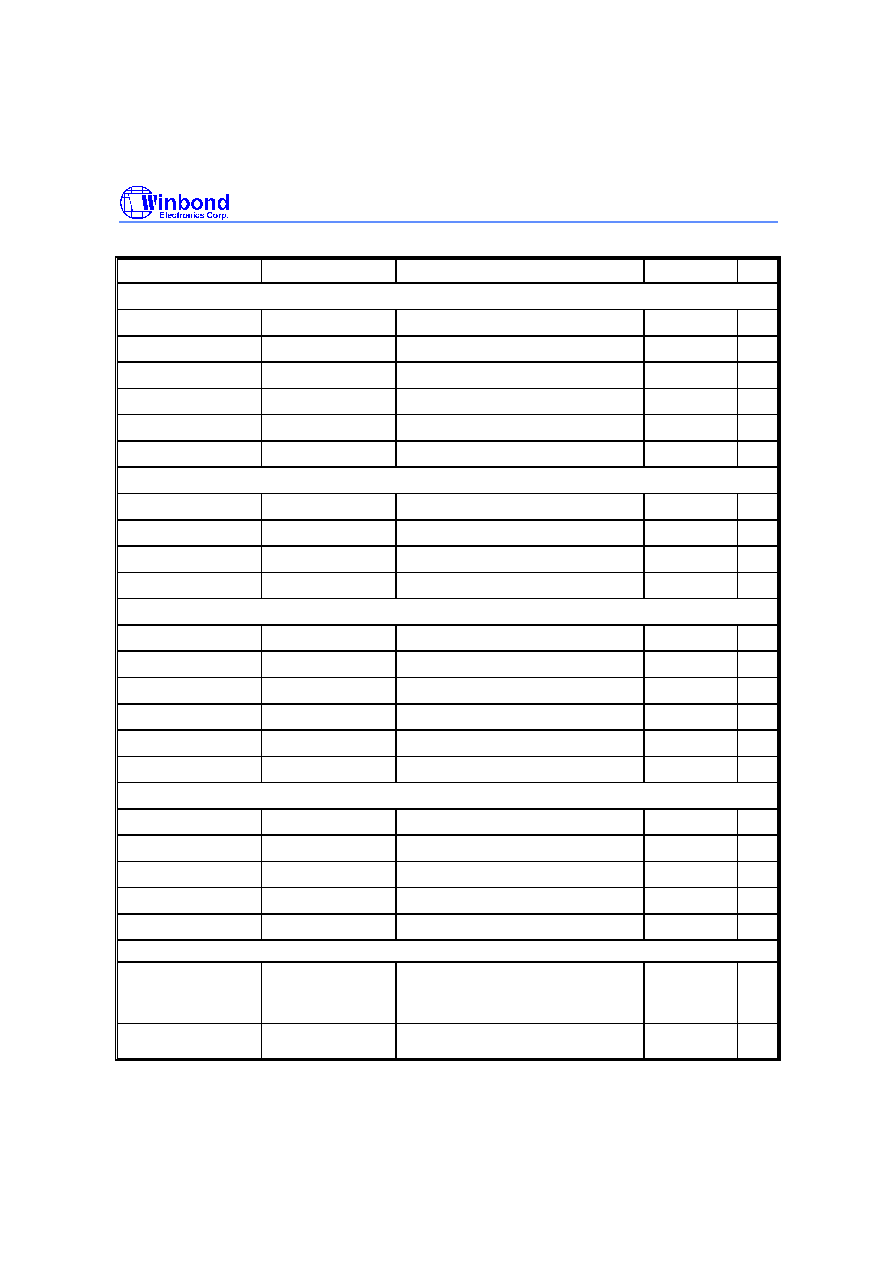
Preliminary W742E81A/W742C81A
- 44 -
Instruction set, continued
Machine code
Mnemonic
Function
Flag affected
W/C
LCD
1001 1000 0xxx xxxx
MOV
LPL, R
LPL
(R)
1/1
1001 1000 1xxx xxxx
MOV
LPH, R
LPH
(R)
1/1
1001 1010 0xxx xxxx
MOV
@LP, R
[(LPH)
◊
10H+(LPL)]
(R)
1/1
1001 1011 0xxx xxxx
MOV
R, @LP
R
[
(LPH)
◊
10H+(LPL)]
1/1
0000 0010 0000 0000
LCDON
LCD ON
1/1
0000 0010 1000 0000
LCDOFF
LCD OFF
1/1
MFP
0011 0110 0000 000i
MOV
BUZCR, #I
BUZCR
I
1/1
1000 1010 0xxx xxxx
MOV
BUZCR, R
BUZCR
(R)
1/1
1000 1011 0xxx xxxx
MOV
R,BUZCR
R
(BUZCR)
1/1
0001 0010 i i i i i i i i
MOV
MFP, #I
[MFP]
I
1/1
Timer
1010 1010 0xxx xxxx
MOV
TM0L, R
TM0L
(R)
1/1
1010 1010 1xxx xxxx
MOV
TM0H, R
TM0H
(R)
1/1
1010 1011 0xxx xxxx
MOV
TM1L, R
TM1L
(R)
1/1
1010 1011 1xxx xxxx
MOV
TM1H, R
TM1H
(R)
1/1
0001 0011 1000 i00i
MOV
MR0,#I
MR0
(R)
1/1
0001 0011 0000 iiii
MOV
MR1,#I
MR1
(R)
1/1
Other
0000 0000 1000 0000
HOLD
Enter Hold mode
1/1
0000 0000 1100 0000
STOP
Enter Stop mode
1/1
0000 0000 0000 0000
NOP
No operation
1/1
0101 0000 1100 0000
EN
INT
Enable interrupt function
1/1
0101 0000 1000 0000
DIS
INT
Disable interrupt function
1/1
Subroutine
0110 0aaa aaaa aaaa
CALL
L
Push Stack:
STACK <- PC+1, TAB0, TAB1, TAB2, TAB3,
DBKR, WRP, ROMPR, PAGE, ACC, CF;
PC12~PC0<- (ROMPR)x800H+L10~L0
1/1
0000 0001 iiii iiii
RTN
#I
(PC) <- STACK; Pop other register by I Table
setting (Refer to Table 8)
1/1
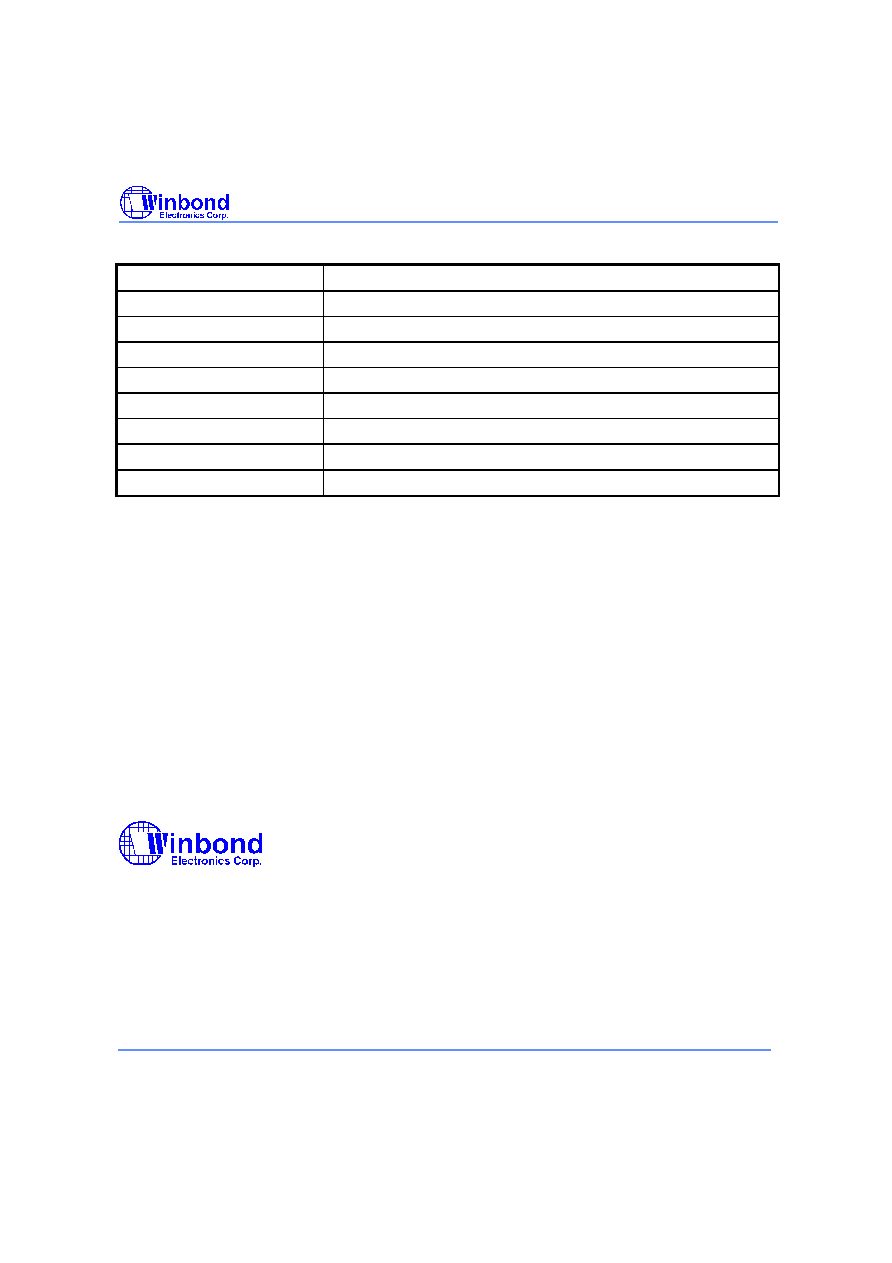
Preliminary W742E81A/W742C81A
Publication Release Date: April 2000
- 45 - Revision A1
Table 8 The bit definition of RTN
BIT DEFINITION OF I
I = 0000 0000
Pop
PC from stack only
bit0 = 1
Pop
PC and TAB0, TAB1, TAB2, TAB3 from stack
bit1 = 1
Pop
PC and DBKR from stack
bit2 = 1
Pop
PC and WRP from stack
bit3 = 1
Pop
PC and ROMPR from stack
bit4 = 1
Pop
PC and PAGE from stack
bit5 = 1
Pop
PC and ACC from stack
bit6 = 1
Pop
PC and CF from stack
Headquarters
No. 4, Creation Rd. III,
Science-Based Industrial Park,
Hsinchu, Taiwan
TEL: 886-3-5770066
FAX: 886-3-5792766
http://www.winbond.com.tw/
Voice & Fax-on-demand: 886-2-27197006
Taipei Office
11F, No. 115, Sec. 3, Min-Sheng East Rd.,
Taipei, Taiwan
TEL: 886-2-27190505
FAX: 886-2-27197502
Winbond Electronics (H.K.) Ltd.
Rm. 803, World Trade Square, Tower II,
123 Hoi Bun Rd., Kwun Tong,
Kowloon, Hong Kong
TEL: 852-27513100
FAX: 852-27552064
Winbond Electronics North America Corp.
Winbond Memory Lab.
Winbond Microelectronics Corp.
Winbond Systems Lab.
2727 N. First Street, San Jose,
CA 95134, U.S.A.
TEL: 408-9436666
FAX: 408-5441798
Note: All data and specifications are subject to change without notice.












































